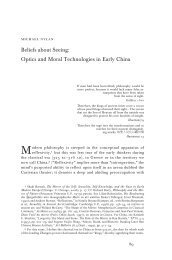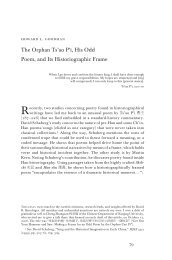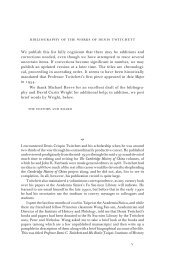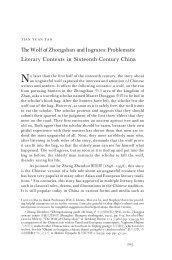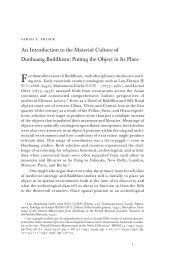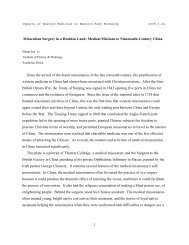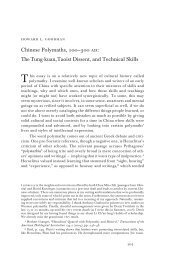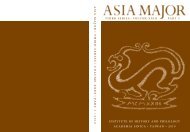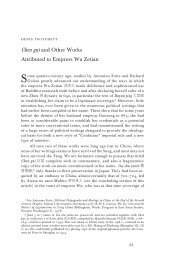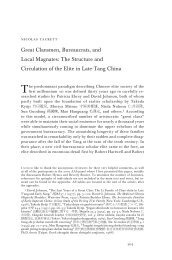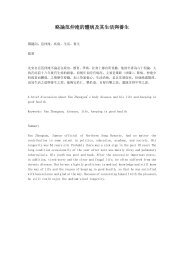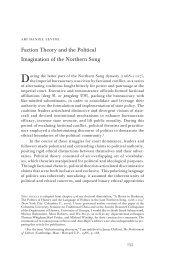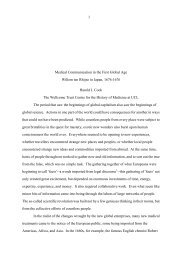Recent Research in China on Wei-Jin Nanbeichao History
Recent Research in China on Wei-Jin Nanbeichao History
Recent Research in China on Wei-Jin Nanbeichao History
Create successful ePaper yourself
Turn your PDF publications into a flip-book with our unique Google optimized e-Paper software.
ecent research <str<strong>on</strong>g>in</str<strong>on</strong>g> ch<str<strong>on</strong>g>in</str<strong>on</strong>g>a<br />
hou xud<strong>on</strong>g 侯 旭 東<br />
translated and edited by howard l. goodman<br />
<str<strong>on</strong>g>Recent</str<strong>on</strong>g> <str<strong>on</strong>g>Research</str<strong>on</strong>g> <str<strong>on</strong>g>in</str<strong>on</strong>g> Ch<str<strong>on</strong>g>in</str<strong>on</strong>g>a <strong>on</strong><br />
<strong>Wei</strong>-J<str<strong>on</strong>g>in</str<strong>on</strong>g> <strong>Nanbeichao</strong> <strong>History</strong><br />
Changes <str<strong>on</strong>g>in</str<strong>on</strong>g> the Compositi<strong>on</strong> of <str<strong>on</strong>g>Research</str<strong>on</strong>g>ers<br />
In Ch<str<strong>on</strong>g>in</str<strong>on</strong>g>a there has been a complete generati<strong>on</strong>al shift <str<strong>on</strong>g>in</str<strong>on</strong>g> the pers<strong>on</strong>nel<br />
engaged <str<strong>on</strong>g>in</str<strong>on</strong>g> research. Dur<str<strong>on</strong>g>in</str<strong>on</strong>g>g the 1950s and 60s university graduates<br />
basically withdrew from research work, and those work<str<strong>on</strong>g>in</str<strong>on</strong>g>g currently<br />
ma<str<strong>on</strong>g>in</str<strong>on</strong>g>ly are a scholar cohort born <str<strong>on</strong>g>in</str<strong>on</strong>g> the 50s and 60s and graduated after<br />
the 80s; young people born <str<strong>on</strong>g>in</str<strong>on</strong>g> the 70s and graduated around 2000<br />
have begun to enter academic careers and thus are emerg<str<strong>on</strong>g>in</str<strong>on</strong>g>g nicely as<br />
a talented cohort. Aga<str<strong>on</strong>g>in</str<strong>on</strong>g>st a general background of reform and open<str<strong>on</strong>g>in</str<strong>on</strong>g>g<br />
up, these scholars have received the appropriate systematic skills.<br />
C<strong>on</strong>ceptually, relatively few have received strictures <str<strong>on</strong>g>in</str<strong>on</strong>g> their forms of<br />
th<str<strong>on</strong>g>in</str<strong>on</strong>g>k<str<strong>on</strong>g>in</str<strong>on</strong>g>g, and their outlook is broadm<str<strong>on</strong>g>in</str<strong>on</strong>g>ded. However, hav<str<strong>on</strong>g>in</str<strong>on</strong>g>g been<br />
completely formed by the structure of today’s course-work, where little<br />
about traditi<strong>on</strong>al culture reaches a rich level of discussi<strong>on</strong> and the gap<br />
separat<str<strong>on</strong>g>in</str<strong>on</strong>g>g us from ancient cultures grows ever deeper, any “sympathetic<br />
explanati<strong>on</strong>” of history becomes difficult. From another aspect,<br />
<str<strong>on</strong>g>in</str<strong>on</strong>g> recent years history educati<strong>on</strong> has lacked systematicity and careful<br />
thought and plann<str<strong>on</strong>g>in</str<strong>on</strong>g>g. Tra<str<strong>on</strong>g>in</str<strong>on</strong>g><str<strong>on</strong>g>in</str<strong>on</strong>g>g <str<strong>on</strong>g>in</str<strong>on</strong>g> the history of scholarship and <str<strong>on</strong>g>in</str<strong>on</strong>g> theory<br />
and method, as well as <str<strong>on</strong>g>in</str<strong>on</strong>g> language tools, have all been <str<strong>on</strong>g>in</str<strong>on</strong>g>sufficient<br />
and have <str<strong>on</strong>g>in</str<strong>on</strong>g>nately restricted the future development of research.<br />
This issue of Asia Major departs from our normal format <str<strong>on</strong>g>in</str<strong>on</strong>g> several ways. Here and <str<strong>on</strong>g>in</str<strong>on</strong>g> the<br />
other translated articles, we have not set authors’ footnotes verbatim but moved their citati<strong>on</strong>s<br />
<str<strong>on</strong>g>in</str<strong>on</strong>g>to Bibliographies. Thus see Hou Xud<strong>on</strong>g’s orig<str<strong>on</strong>g>in</str<strong>on</strong>g>al footnote citati<strong>on</strong>s for his Introducti<strong>on</strong><br />
at the end. I thank the author for his cooperati<strong>on</strong> <str<strong>on</strong>g>in</str<strong>on</strong>g> improv<str<strong>on</strong>g>in</str<strong>on</strong>g>g my translati<strong>on</strong> and <str<strong>on</strong>g>in</str<strong>on</strong>g> other<br />
matters of edit<str<strong>on</strong>g>in</str<strong>on</strong>g>g and proof<str<strong>on</strong>g>in</str<strong>on</strong>g>g, <str<strong>on</strong>g>in</str<strong>on</strong>g>clud<str<strong>on</strong>g>in</str<strong>on</strong>g>g unst<str<strong>on</strong>g>in</str<strong>on</strong>g>t<str<strong>on</strong>g>in</str<strong>on</strong>g>g help dur<str<strong>on</strong>g>in</str<strong>on</strong>g>g several meet<str<strong>on</strong>g>in</str<strong>on</strong>g>gs with other<br />
authors <str<strong>on</strong>g>in</str<strong>on</strong>g> Beij<str<strong>on</strong>g>in</str<strong>on</strong>g>g.<br />
1
hou xud<strong>on</strong>g<br />
New Directi<strong>on</strong>s <str<strong>on</strong>g>in</str<strong>on</strong>g> <str<strong>on</strong>g>Research</str<strong>on</strong>g><br />
<str<strong>on</strong>g>Research</str<strong>on</strong>g> encompass<str<strong>on</strong>g>in</str<strong>on</strong>g>g the ru and their ritual programs<br />
<str<strong>on</strong>g>Recent</str<strong>on</strong>g>ly, c<strong>on</strong>centrated research has focused <strong>on</strong> rituals. Several<br />
scholars have co<str<strong>on</strong>g>in</str<strong>on</strong>g>cidentally given their own visi<strong>on</strong> to this questi<strong>on</strong>.<br />
Beg<str<strong>on</strong>g>in</str<strong>on</strong>g>n<str<strong>on</strong>g>in</str<strong>on</strong>g>g <str<strong>on</strong>g>in</str<strong>on</strong>g> 2001, liang Mancang 梁 滿 倉 has published a series of<br />
papers (and now a recent book) that discuss, for example, the <str<strong>on</strong>g>in</str<strong>on</strong>g>stituti<strong>on</strong>alizati<strong>on</strong><br />
of the system of “Five Rites 五 禮 ” (Wuli) of the <strong>Wei</strong>, J<str<strong>on</strong>g>in</str<strong>on</strong>g>,<br />
and Southern and Northern dynasties (hereafter, stated as “<strong>Nanbeichao</strong>”<br />
or “<strong>Wei</strong>-J<str<strong>on</strong>g>in</str<strong>on</strong>g> <strong>Nanbeichao</strong>” 魏 晉 南 北 朝 ), as well as military music<br />
and discussi<strong>on</strong>s of military rituals. He po<str<strong>on</strong>g>in</str<strong>on</strong>g>ted out how the Five Rites,<br />
orig<str<strong>on</strong>g>in</str<strong>on</strong>g>at<str<strong>on</strong>g>in</str<strong>on</strong>g>g from the secti<strong>on</strong> titled “Officers of the Spr<str<strong>on</strong>g>in</str<strong>on</strong>g>g: Da z<strong>on</strong>gbo”<br />
春 官 : 大 宗 伯 <str<strong>on</strong>g>in</str<strong>on</strong>g> Zhouli 周 禮 (Rites of Zhou), began to be coord<str<strong>on</strong>g>in</str<strong>on</strong>g>ated to<br />
court programs dur<str<strong>on</strong>g>in</str<strong>on</strong>g>g the transiti<strong>on</strong> from <strong>Wei</strong> to J<str<strong>on</strong>g>in</str<strong>on</strong>g>, and basically<br />
completed <str<strong>on</strong>g>in</str<strong>on</strong>g> Liang times under the Xiao rulers. In northern Ch<str<strong>on</strong>g>in</str<strong>on</strong>g>a,<br />
the Five Rites system was established dur<str<strong>on</strong>g>in</str<strong>on</strong>g>g the Taihe (477–499 ad)<br />
period of Northern <strong>Wei</strong> emperor Xiaowen 孝 文 帝 . C<strong>on</strong>cern<str<strong>on</strong>g>in</str<strong>on</strong>g>g this<br />
matter of the essential core of rites studies, Pi Xirui already noticed<br />
that the ruists of Han times emphasized Yili 儀 禮 and <str<strong>on</strong>g>in</str<strong>on</strong>g> <strong>Wei</strong>-J<str<strong>on</strong>g>in</str<strong>on</strong>g> they<br />
emphasized Zhouli, and Liang has written a detailed study of this that<br />
reveals a major change between the Han and <strong>Wei</strong>-J<str<strong>on</strong>g>in</str<strong>on</strong>g> <strong>Nanbeichao</strong> ritual<br />
systems – both at the level of classic texts and practices. Unlike the<br />
perspective used <str<strong>on</strong>g>in</str<strong>on</strong>g> Liang Mancang’s history of the Rites, yan Buke’s<br />
閻 步 克 is based <strong>on</strong> the “Six Caps” ritual system from Han to S<strong>on</strong>g and<br />
M<str<strong>on</strong>g>in</str<strong>on</strong>g>g, an <str<strong>on</strong>g>in</str<strong>on</strong>g>stituti<strong>on</strong>al history whose ma<str<strong>on</strong>g>in</str<strong>on</strong>g> aspect <str<strong>on</strong>g>in</str<strong>on</strong>g> regard to the medieval<br />
period was taken from Zhouli; he has d<strong>on</strong>e a meticulous comb<str<strong>on</strong>g>in</str<strong>on</strong>g>g<br />
through and compar<str<strong>on</strong>g>in</str<strong>on</strong>g>g of <strong>Nanbeichao</strong> usages, show<str<strong>on</strong>g>in</str<strong>on</strong>g>g the relati<strong>on</strong>ship<br />
between traditi<strong>on</strong> and reality, and between culture and politics, under<br />
the traditi<strong>on</strong>al imperial system. From his summary, two c<strong>on</strong>flict<str<strong>on</strong>g>in</str<strong>on</strong>g>g<br />
tendencies emerge: the authority of the C<strong>on</strong>fucian classics and historicist<br />
“fundamentalism” (fugu 復 古 ), <strong>on</strong> the <strong>on</strong>e hand, and reverence of<br />
the emperor versus officials’ practical needs, <strong>on</strong> the other. On the role<br />
of Zhouli dur<str<strong>on</strong>g>in</str<strong>on</strong>g>g the Middle Ages, the author has summarized it as a<br />
“Renaissance Movement <str<strong>on</strong>g>in</str<strong>on</strong>g> Ancient Rites.” lou J<str<strong>on</strong>g>in</str<strong>on</strong>g>g 樓 勁 c<strong>on</strong>ducted<br />
a meticulous <str<strong>on</strong>g>in</str<strong>on</strong>g>vestigati<strong>on</strong> of the various <str<strong>on</strong>g>in</str<strong>on</strong>g>stituti<strong>on</strong>al creati<strong>on</strong>s under<br />
Northern <strong>Wei</strong> founder Daowu 道 武 帝 , also emphasiz<str<strong>on</strong>g>in</str<strong>on</strong>g>g the profound<br />
impact of Zhouli. In additi<strong>on</strong>, guo Shanb<str<strong>on</strong>g>in</str<strong>on</strong>g>g 郭 善 兵 <str<strong>on</strong>g>in</str<strong>on</strong>g> recent years<br />
has focused <strong>on</strong> ancestral temple worship dur<str<strong>on</strong>g>in</str<strong>on</strong>g>g the <strong>Wei</strong>-J<str<strong>on</strong>g>in</str<strong>on</strong>g> and <strong>Nanbeichao</strong>.<br />
On this matter, I also have d<strong>on</strong>e some sketchy comb<str<strong>on</strong>g>in</str<strong>on</strong>g>g of<br />
materials <strong>on</strong> the culture of court rites and music.<br />
2
ecent research <str<strong>on</strong>g>in</str<strong>on</strong>g> ch<str<strong>on</strong>g>in</str<strong>on</strong>g>a<br />
The literary sources of the <strong>Wei</strong>-J<str<strong>on</strong>g>in</str<strong>on</strong>g> and <strong>Nanbeichao</strong> make it seem<br />
that metaphysics, Buddhism, and Taoism dom<str<strong>on</strong>g>in</str<strong>on</strong>g>ated the realm of<br />
thought, and that C<strong>on</strong>fucianism found itself <str<strong>on</strong>g>in</str<strong>on</strong>g> a “slumber<str<strong>on</strong>g>in</str<strong>on</strong>g>g” c<strong>on</strong>diti<strong>on</strong>.<br />
Many <str<strong>on</strong>g>in</str<strong>on</strong>g> modern times believed this impressi<strong>on</strong>, and thus they<br />
paid scant attenti<strong>on</strong> to C<strong>on</strong>fucianists and C<strong>on</strong>fucianism. But studies of<br />
state ritual, as just menti<strong>on</strong>ed, give us another picture. Although the<br />
study of the classics received a severe drubb<str<strong>on</strong>g>in</str<strong>on</strong>g>g, still it occupied the<br />
core of political thought and was develop<str<strong>on</strong>g>in</str<strong>on</strong>g>g its strength with Zhouli<br />
as the central ritual teach<str<strong>on</strong>g>in</str<strong>on</strong>g>g. By so do<str<strong>on</strong>g>in</str<strong>on</strong>g>g, classicism would have an<br />
important and last<str<strong>on</strong>g>in</str<strong>on</strong>g>g <str<strong>on</strong>g>in</str<strong>on</strong>g>fluence <strong>on</strong> later generati<strong>on</strong>s. The researches<br />
of zhu Z<strong>on</strong>gb<str<strong>on</strong>g>in</str<strong>on</strong>g> 祝 總 斌 , yan Yaozh<strong>on</strong>g 嚴 耀 中 , and he Dezhang 何 德<br />
章 have provided serious reevaluati<strong>on</strong>s. They will cause us to be more<br />
comprehensive and balanced <str<strong>on</strong>g>in</str<strong>on</strong>g> our understand<str<strong>on</strong>g>in</str<strong>on</strong>g>g of the <str<strong>on</strong>g>in</str<strong>on</strong>g>tellectual<br />
atmosphere of any time-period. C<strong>on</strong>currently, as the study of early rites<br />
becomes emphasized, it will break up the way current academic fields<br />
are arranged and will profoundly affect our noti<strong>on</strong>s about the deeper<br />
implicati<strong>on</strong>s found <str<strong>on</strong>g>in</str<strong>on</strong>g> the terms and ideas of traditi<strong>on</strong>al scholarship. This<br />
is beneficial, s<str<strong>on</strong>g>in</str<strong>on</strong>g>ce the language of our sources often obscures realities,<br />
and the study of rites helps us to avoid mis<str<strong>on</strong>g>in</str<strong>on</strong>g>terpretati<strong>on</strong>s.<br />
<strong>History</strong> of law<br />
S<str<strong>on</strong>g>in</str<strong>on</strong>g>ce 2001, lou J<str<strong>on</strong>g>in</str<strong>on</strong>g>g has made numerous researches <str<strong>on</strong>g>in</str<strong>on</strong>g>to legal<br />
problems of the Northern Dynasties, such as specific c<strong>on</strong>diti<strong>on</strong>s<br />
surround<str<strong>on</strong>g>in</str<strong>on</strong>g>g the promulgati<strong>on</strong> of Northern <strong>Wei</strong> adm<str<strong>on</strong>g>in</str<strong>on</strong>g>istrative code,<br />
Northern <strong>Wei</strong> regulati<strong>on</strong>s, and the impilicati<strong>on</strong> of the terms “ge 格 ” and<br />
“shi 式 ” and their status <str<strong>on</strong>g>in</str<strong>on</strong>g> Ch<str<strong>on</strong>g>in</str<strong>on</strong>g>a’s legal history. He dem<strong>on</strong>strates that<br />
the well-known “L<str<strong>on</strong>g>in</str<strong>on</strong>g>zhi Regulati<strong>on</strong>s 麟 趾 格 ” of the Northern Qi dynasty<br />
were <str<strong>on</strong>g>in</str<strong>on</strong>g> fact penal codes. Next, han Shufeng 韓 樹 峰 , apart from<br />
study<str<strong>on</strong>g>in</str<strong>on</strong>g>g Han-dynasty crim<str<strong>on</strong>g>in</str<strong>on</strong>g>al penalties, has made detailed analyses of<br />
<strong>Wei</strong>-J<str<strong>on</strong>g>in</str<strong>on</strong>g> changes <str<strong>on</strong>g>in</str<strong>on</strong>g> the forms of laws, such as the emergence of “Laws<br />
for Prescrib<str<strong>on</strong>g>in</str<strong>on</strong>g>g Punishments 刑 名 律 ,” and “Laws for Describ<str<strong>on</strong>g>in</str<strong>on</strong>g>g Penal<br />
Case Pr<str<strong>on</strong>g>in</str<strong>on</strong>g>ciples 名 例 律 .” He has po<str<strong>on</strong>g>in</str<strong>on</strong>g>ted out that not <strong>on</strong>ly did <strong>Wei</strong> law<br />
undergo a C<strong>on</strong>fucianizati<strong>on</strong> of its c<strong>on</strong>tents, but <str<strong>on</strong>g>in</str<strong>on</strong>g> terms of form it also<br />
established a new style under the <str<strong>on</strong>g>in</str<strong>on</strong>g>fluence of xuanxue metaphysics,<br />
which also provided for a developmental directi<strong>on</strong> <str<strong>on</strong>g>in</str<strong>on</strong>g> later legal formulati<strong>on</strong>s.<br />
Based <strong>on</strong> years of study<str<strong>on</strong>g>in</str<strong>on</strong>g>g medieval legal history, <str<strong>on</strong>g>in</str<strong>on</strong>g> 2001<br />
ye <strong>Wei</strong> 葉 煒 published <strong>on</strong> the Northern Zhou “Great Laws 大 律 ,” and<br />
most recently wrote an article that analyzed the reas<strong>on</strong>s beh<str<strong>on</strong>g>in</str<strong>on</strong>g>d the rise<br />
and fall of <strong>Wei</strong>-J<str<strong>on</strong>g>in</str<strong>on</strong>g> and S<strong>on</strong>g legal scholarship. He recognizes that the<br />
reas<strong>on</strong> for attenuati<strong>on</strong> was not because, as frequently said, “the literati<br />
just then <strong>on</strong>ly barely learned or understood the law,” <str<strong>on</strong>g>in</str<strong>on</strong>g>stead, with the<br />
3
hou xud<strong>on</strong>g<br />
overall new emphasis <strong>on</strong> classicist term<str<strong>on</strong>g>in</str<strong>on</strong>g>ology and ruist scholarship,<br />
the government wanted comm<strong>on</strong>place civil servants to achieve skills<br />
<str<strong>on</strong>g>in</str<strong>on</strong>g> basic law.<br />
Han through Tang legal history has received correcti<strong>on</strong>s and has<br />
become energized because of newly unearthed sources, and based <strong>on</strong><br />
those we can make ga<str<strong>on</strong>g>in</str<strong>on</strong>g>s <str<strong>on</strong>g>in</str<strong>on</strong>g> <strong>Wei</strong>-J<str<strong>on</strong>g>in</str<strong>on</strong>g> <strong>Nanbeichao</strong> legal history. In 2002,<br />
tombs opened <str<strong>on</strong>g>in</str<strong>on</strong>g> rural Gansu, Yumen 玉 門 city, Huahai hamlet 花 海 ,<br />
have given us manuscripts of commentary to the J<str<strong>on</strong>g>in</str<strong>on</strong>g> Code, from about<br />
the time of the Sixteen K<str<strong>on</strong>g>in</str<strong>on</strong>g>gdoms Liang dynasty. The title is “Explanati<strong>on</strong>s<br />
of the Nobiliary Law, chapter 20” 諸 侯 律 注 , 第 廿 and is roughly<br />
5,000 words <str<strong>on</strong>g>in</str<strong>on</strong>g> length.<br />
Bureaucratic history<br />
Mr. yan Buke, hav<str<strong>on</strong>g>in</str<strong>on</strong>g>g c<strong>on</strong>tributed research <strong>on</strong> the Q<str<strong>on</strong>g>in</str<strong>on</strong>g>-Han,<br />
<strong>Wei</strong>-J<str<strong>on</strong>g>in</str<strong>on</strong>g>, and <strong>Nanbeichao</strong> rank system, and ref<str<strong>on</strong>g>in</str<strong>on</strong>g>ed a “grade status”<br />
and “office status” perspective <str<strong>on</strong>g>in</str<strong>on</strong>g> analyz<str<strong>on</strong>g>in</str<strong>on</strong>g>g the evoluti<strong>on</strong> of the system<br />
throughout imperial Ch<str<strong>on</strong>g>in</str<strong>on</strong>g>a, has made a proporti<strong>on</strong>ate impact <strong>on</strong> young<br />
scholars. Many recent studies of political systems adopt his perspective<br />
and expand it; for example, the research of ye <strong>Wei</strong>, zhang Xiaowen<br />
張 小 穩 , and gu Jiangl<strong>on</strong>g 顧 江 龍 . Mr. Yan’s recent proposal to go bey<strong>on</strong>d<br />
the noti<strong>on</strong> of “chr<strong>on</strong>ological stages” and “transformati<strong>on</strong>,” and<br />
to recognize <str<strong>on</strong>g>in</str<strong>on</strong>g> Ch<str<strong>on</strong>g>in</str<strong>on</strong>g>ese history its “cyclicality” and “c<strong>on</strong>t<str<strong>on</strong>g>in</str<strong>on</strong>g>uity,” and<br />
what was “stable” and what “shift<str<strong>on</strong>g>in</str<strong>on</strong>g>g” <str<strong>on</strong>g>in</str<strong>on</strong>g> Ch<str<strong>on</strong>g>in</str<strong>on</strong>g>ese empires, deserves<br />
c<strong>on</strong>t<str<strong>on</strong>g>in</str<strong>on</strong>g>ued attenti<strong>on</strong>.<br />
In recent years Mr. luo X<str<strong>on</strong>g>in</str<strong>on</strong>g> 羅 新 has been committed to research<br />
<strong>on</strong> post-Han-<strong>Wei</strong>-era northern clan names and has published a series<br />
of papers. The particulars are more fully absorbed under the field of<br />
modern <str<strong>on</strong>g>in</str<strong>on</strong>g>ternati<strong>on</strong>al Altaic Studies; <str<strong>on</strong>g>in</str<strong>on</strong>g> fact they are the results of research<br />
<str<strong>on</strong>g>in</str<strong>on</strong>g> Altaic l<str<strong>on</strong>g>in</str<strong>on</strong>g>guistics and take advantage of <str<strong>on</strong>g>in</str<strong>on</strong>g>scripti<strong>on</strong>s and Ch<str<strong>on</strong>g>in</str<strong>on</strong>g>ese<br />
documents unearthed <str<strong>on</strong>g>in</str<strong>on</strong>g> Central Asia. By means of etymologies<br />
of names, and by f<str<strong>on</strong>g>in</str<strong>on</strong>g>d<str<strong>on</strong>g>in</str<strong>on</strong>g>g out similar nam<str<strong>on</strong>g>in</str<strong>on</strong>g>g used for different tribes<br />
and determ<str<strong>on</strong>g>in</str<strong>on</strong>g><str<strong>on</strong>g>in</str<strong>on</strong>g>g their mean<str<strong>on</strong>g>in</str<strong>on</strong>g>gs, he has come up with basic clues and<br />
an evoluti<strong>on</strong>ary pattern for the way tribal titles became differentiated.<br />
He has proposed a developmental structure <str<strong>on</strong>g>in</str<strong>on</strong>g> the way tribal titles and<br />
pers<strong>on</strong>al appellati<strong>on</strong>s were differentiated, as reflected <str<strong>on</strong>g>in</str<strong>on</strong>g> later official<br />
titles and designati<strong>on</strong>s. Specifically this is related to the Xi<strong>on</strong>g nu Shan yu<br />
匈 奴 單 于 , the Northern <strong>Wei</strong> “Zhiq<str<strong>on</strong>g>in</str<strong>on</strong>g> 直 勤 ,” the Yeda 嚈 噠 “Chiq<str<strong>on</strong>g>in</str<strong>on</strong>g> 敕 勤 ,”<br />
the Tujue (Turk) “Teq<str<strong>on</strong>g>in</str<strong>on</strong>g> 特 勤 ,” and the names ga<str<strong>on</strong>g>in</str<strong>on</strong>g>ed by the Tuoba;<br />
furthermore the Xianbei, Rouran, Tujue, Tiele, and Qidan khan 可 汗<br />
appellati<strong>on</strong>s, and even post-Tang emperors’ appellati<strong>on</strong>s, and so <strong>on</strong>.<br />
With this, he has tried to explore clues to the appearance and devel-<br />
4
ecent research <str<strong>on</strong>g>in</str<strong>on</strong>g> ch<str<strong>on</strong>g>in</str<strong>on</strong>g>a<br />
opment of the titles of Northern tribes and bureaucratic titles; and because<br />
of this has renewed awareness of the political development of the<br />
northern tribes, as well as their <str<strong>on</strong>g>in</str<strong>on</strong>g>fluence <strong>on</strong> Han regimes (such as the<br />
emergence of imperial titles). Luo is attempt<str<strong>on</strong>g>in</str<strong>on</strong>g>g to probe the threads<br />
l<str<strong>on</strong>g>in</str<strong>on</strong>g>k<str<strong>on</strong>g>in</str<strong>on</strong>g>g Northern Ch<str<strong>on</strong>g>in</str<strong>on</strong>g>a’s tribal titles with the growth and development<br />
of office titles <str<strong>on</strong>g>in</str<strong>on</strong>g> their state bureaucracy, and, based <strong>on</strong> this, to recognize<br />
the development of Northern Ch<str<strong>on</strong>g>in</str<strong>on</strong>g>ese tribal governments, <str<strong>on</strong>g>in</str<strong>on</strong>g>clud<str<strong>on</strong>g>in</str<strong>on</strong>g>g<br />
how they reflected Han power structures (for <str<strong>on</strong>g>in</str<strong>on</strong>g>stance, the phenomen<strong>on</strong><br />
of emperors’ names). Most recently, his research has turned to<br />
how the Tuoba Xianbei ga<str<strong>on</strong>g>in</str<strong>on</strong>g>ed and solidified their appellati<strong>on</strong>s and<br />
how this was more generally l<str<strong>on</strong>g>in</str<strong>on</strong>g>ked to changes <str<strong>on</strong>g>in</str<strong>on</strong>g> the development of<br />
tribal organizati<strong>on</strong>s. He sees those whose pers<strong>on</strong>al identity (at least<br />
partly state titles) developed <str<strong>on</strong>g>in</str<strong>on</strong>g>to specific pers<strong>on</strong>al names with<str<strong>on</strong>g>in</str<strong>on</strong>g> the<br />
tribe as the heroic leaders who guided the clans’ way from tribes to<br />
chiefdoms, <str<strong>on</strong>g>in</str<strong>on</strong>g> particular the various Xianbei tribes which for the most<br />
part received appellati<strong>on</strong>s dur<str<strong>on</strong>g>in</str<strong>on</strong>g>g the <strong>Wei</strong>-J<str<strong>on</strong>g>in</str<strong>on</strong>g> era. Luo po<str<strong>on</strong>g>in</str<strong>on</strong>g>ts out that<br />
it was at this very moment that the Xianbei tribes sprang forward <str<strong>on</strong>g>in</str<strong>on</strong>g><br />
their political growth.<br />
These studies provide important stimuli. In additi<strong>on</strong>, there is a<br />
relatively large amount of research <strong>on</strong> wartime field regimes (or, bakufu<br />
幕 府 ), <strong>on</strong> tyrant regimes and military regimes, the ma<str<strong>on</strong>g>in</str<strong>on</strong>g> research be<str<strong>on</strong>g>in</str<strong>on</strong>g>g<br />
that of zhang Jun 張 軍 , l<str<strong>on</strong>g>in</str<strong>on</strong>g> Xiaosheng 林 校 生 , tao Xiandu 陶 賢 都 ,<br />
and fang Jianchun 方 建 春 .<br />
Regi<strong>on</strong>al history<br />
Hav<str<strong>on</strong>g>in</str<strong>on</strong>g>g recently read research deal<str<strong>on</strong>g>in</str<strong>on</strong>g>g with envir<strong>on</strong>mental changes<br />
<str<strong>on</strong>g>in</str<strong>on</strong>g> Xi’an dur<str<strong>on</strong>g>in</str<strong>on</strong>g>g the Han through Tang, those leav<str<strong>on</strong>g>in</str<strong>on</strong>g>g the str<strong>on</strong>gest impressi<strong>on</strong><br />
touched <strong>on</strong> the impact <strong>on</strong> the envir<strong>on</strong>ment made by Chang’an<br />
temples <str<strong>on</strong>g>in</str<strong>on</strong>g> Tang times and pre-Tang envir<strong>on</strong>mental fluctuati<strong>on</strong>s and<br />
their relati<strong>on</strong>ship with changes <str<strong>on</strong>g>in</str<strong>on</strong>g> the Xi’an surround<str<strong>on</strong>g>in</str<strong>on</strong>g>g forest cover;<br />
with the result of mak<str<strong>on</strong>g>in</str<strong>on</strong>g>g comparis<strong>on</strong>s of changes <str<strong>on</strong>g>in</str<strong>on</strong>g> animal and plant<br />
species between modern and Han-era Changan. These studies have<br />
expanded and ref<str<strong>on</strong>g>in</str<strong>on</strong>g>ed our research <str<strong>on</strong>g>in</str<strong>on</strong>g>to regi<strong>on</strong>al envir<strong>on</strong>ments (<str<strong>on</strong>g>in</str<strong>on</strong>g> the<br />
Bibliography, see under Tangdu xuekan).<br />
New Sources: Sanguo Wu Bamboo Slips, Turfan Documents, and Sogdian<br />
Tombs<br />
“Bamboo Slips, Two” and “Three” were published <str<strong>on</strong>g>in</str<strong>on</strong>g> 2007 and<br />
2008, respectively, and “Four” will appear early <str<strong>on</strong>g>in</str<strong>on</strong>g> 2010, thus attract<str<strong>on</strong>g>in</str<strong>on</strong>g>g<br />
even more research <strong>on</strong> the Wu Slips. In 2006 “Wu Slips <str<strong>on</strong>g>Research</str<strong>on</strong>g>,”<br />
series 2, was published. (For all these titles, see appended Bibliogra-<br />
5
hou xud<strong>on</strong>g<br />
phy under both “Bamboo Slips” and Wu Slips <str<strong>on</strong>g>Research</str<strong>on</strong>g>”.) S<str<strong>on</strong>g>in</str<strong>on</strong>g>ce then,<br />
jiang Fuya 蔣 福 亞 has made some progress <str<strong>on</strong>g>in</str<strong>on</strong>g> research<str<strong>on</strong>g>in</str<strong>on</strong>g>g the matters<br />
c<strong>on</strong>cern<str<strong>on</strong>g>in</str<strong>on</strong>g>g slavery as seen <str<strong>on</strong>g>in</str<strong>on</strong>g> the Wu Slips, and has po<str<strong>on</strong>g>in</str<strong>on</strong>g>ted out<br />
that both apprentices and pers<strong>on</strong>s possess<str<strong>on</strong>g>in</str<strong>on</strong>g>g slim assets zi 訾 (start<str<strong>on</strong>g>in</str<strong>on</strong>g>g<br />
at 50 units) could own slaves; he speculates as well that official slaves<br />
engaged <str<strong>on</strong>g>in</str<strong>on</strong>g> producti<strong>on</strong>. As to this last fact, we can see that our available<br />
<str<strong>on</strong>g>in</str<strong>on</strong>g>formati<strong>on</strong> is limited at present, and thus it is difficult to determ<str<strong>on</strong>g>in</str<strong>on</strong>g>e<br />
anyth<str<strong>on</strong>g>in</str<strong>on</strong>g>g. Jiang also has studied the categories of “guests 客 ,” “board<str<strong>on</strong>g>in</str<strong>on</strong>g>g<br />
guests 食 客 ,” and “limited guests 常 限 客 ,” who were dependents of<br />
landlords, as reflected <str<strong>on</strong>g>in</str<strong>on</strong>g> the Wu Slips. This was recorded <str<strong>on</strong>g>in</str<strong>on</strong>g> household<br />
registers no later than the sixth year of Jiahe (237 ad). “Clerk guests<br />
and commander guests,” who were commanded by lower officials, were<br />
new appellati<strong>on</strong>s for government dependents, appear<str<strong>on</strong>g>in</str<strong>on</strong>g>g no later than<br />
the seventh year of Huangwu (228 ad). Such pers<strong>on</strong>nel arose as product<br />
of the struggles between feudal regimes and landlords.<br />
gao M<str<strong>on</strong>g>in</str<strong>on</strong>g> 高 敏 and li Junm<str<strong>on</strong>g>in</str<strong>on</strong>g>g 李 均 明 have separately discussed<br />
questi<strong>on</strong>s of commodity and rent m<strong>on</strong>eys as seen <strong>on</strong> the Wu Slips. C<strong>on</strong>cern<str<strong>on</strong>g>in</str<strong>on</strong>g>g<br />
“Bamboo Slips, One,” and hu P<str<strong>on</strong>g>in</str<strong>on</strong>g>gsheng 胡 平 生 has corrected<br />
transcripti<strong>on</strong> mistakes <str<strong>on</strong>g>in</str<strong>on</strong>g> place names and pers<strong>on</strong>al names. “Materials<br />
for the <strong>History</strong> of <strong>Wei</strong>, J<str<strong>on</strong>g>in</str<strong>on</strong>g>, <strong>Nanbeichao</strong>, and Sui,” no. 23, edited<br />
at Wuhan University, has made available two sets of Wu Slips texts,<br />
and the research of wei B<str<strong>on</strong>g>in</str<strong>on</strong>g> 魏 斌 <strong>on</strong> the food-loan bamboo slips (as<br />
receipts) of the Sun regime <str<strong>on</strong>g>in</str<strong>on</strong>g> Wu touches <strong>on</strong> the recovery of records<br />
and the relati<strong>on</strong>ship am<strong>on</strong>g various archives, as well as the status and<br />
data <strong>on</strong> food-loans, <str<strong>on</strong>g>in</str<strong>on</strong>g>terest charges, and commodity-gra<str<strong>on</strong>g>in</str<strong>on</strong>g>s. Moreover,<br />
he has published “The Problem of Storehouse Gra<str<strong>on</strong>g>in</str<strong>on</strong>g>s, as Seen <str<strong>on</strong>g>in</str<strong>on</strong>g> the<br />
Zoumalou Wu Slips.”<br />
There has also been some work <strong>on</strong> social shapes and relati<strong>on</strong>ships<br />
at the most local levels, <str<strong>on</strong>g>in</str<strong>on</strong>g>clud<str<strong>on</strong>g>in</str<strong>on</strong>g>g families. An example is my research<br />
<strong>on</strong> the relati<strong>on</strong>ship between community (li 里 ) and hamlet (qiu 丘 ).<br />
In 2007 yu Zhenbo 于 振 波 published “C<strong>on</strong>t<str<strong>on</strong>g>in</str<strong>on</strong>g>ued Explorati<strong>on</strong> of the<br />
Zoumalou Wu Slips,” which centers chiefly <strong>on</strong> the “household” and<br />
<str<strong>on</strong>g>in</str<strong>on</strong>g>volves families, the structure of households, women’s marriage age,<br />
household goods, household-c<strong>on</strong>trolled slaves, and the implicati<strong>on</strong> of<br />
the registrati<strong>on</strong> slips’ use of the terms “poll tax 算 ” and “labor service<br />
事 ,” the implicati<strong>on</strong> of the term “elderly,” and the registrati<strong>on</strong> of apprentices.<br />
A recent article by gao M<str<strong>on</strong>g>in</str<strong>on</strong>g> 高 敏 has discussed the tuntian<br />
屯 田 system of the Sun 孫 regime <str<strong>on</strong>g>in</str<strong>on</strong>g> Wu; most important was that it supplemented<br />
previous research <strong>on</strong> this subject by utiliz<str<strong>on</strong>g>in</str<strong>on</strong>g>g the Wu Slips,<br />
but the work was relatively rushed. In 2006, the matter of “household<br />
extracti<strong>on</strong>” as c<strong>on</strong>ta<str<strong>on</strong>g>in</str<strong>on</strong>g>ed <str<strong>on</strong>g>in</str<strong>on</strong>g> the Wu Slips became a hot issue. Gao M<str<strong>on</strong>g>in</str<strong>on</strong>g>,<br />
6
ecent research <str<strong>on</strong>g>in</str<strong>on</strong>g> ch<str<strong>on</strong>g>in</str<strong>on</strong>g>a<br />
yang Jip<str<strong>on</strong>g>in</str<strong>on</strong>g>g 楊 際 平 , zhang R<strong>on</strong>gqiang 張 榮 強 , and Yu Zhenbo have<br />
separately published papers that <str<strong>on</strong>g>in</str<strong>on</strong>g>volve the various differentiati<strong>on</strong>s<br />
am<strong>on</strong>g poll taxes for children and those for adults; also differentiati<strong>on</strong>s<br />
between statuses of “adult” versus “elderly and young,” the nature of<br />
extracti<strong>on</strong>s and the c<strong>on</strong>tents of household registrati<strong>on</strong> documents. Yang<br />
Jip<str<strong>on</strong>g>in</str<strong>on</strong>g>g’s analysis of “extracti<strong>on</strong>,” start<str<strong>on</strong>g>in</str<strong>on</strong>g>g from Han-dynasty f<str<strong>on</strong>g>in</str<strong>on</strong>g>ancial<br />
policies, sees the extracti<strong>on</strong> payments of the Wu Slips as hav<str<strong>on</strong>g>in</str<strong>on</strong>g>g been<br />
purchased with government-issued m<strong>on</strong>ey, and has noth<str<strong>on</strong>g>in</str<strong>on</strong>g>g to do with<br />
f<str<strong>on</strong>g>in</str<strong>on</strong>g>ance rates or household goods, and as such was a highly unusual tax<br />
schedule. This c<strong>on</strong>stitutes a new perspective.<br />
In additi<strong>on</strong> to the Wu Slips, from October, 2006, to January of<br />
2007, every Wednesday morn<str<strong>on</strong>g>in</str<strong>on</strong>g>g researchers and graduate students<br />
<str<strong>on</strong>g>in</str<strong>on</strong>g> the Beij<str<strong>on</strong>g>in</str<strong>on</strong>g>g area, led by Luo X<str<strong>on</strong>g>in</str<strong>on</strong>g>, met to read the unearthed Eastern<br />
Han bamboo slips from Changsha 長 沙 , D<strong>on</strong>gpai lou 東 牌 樓 , and<br />
later we f<str<strong>on</strong>g>in</str<strong>on</strong>g>ished read<str<strong>on</strong>g>in</str<strong>on</strong>g>g the “Bamboo Slips, 2 and 3.” (Completed,<br />
revised transcripti<strong>on</strong>s were published <str<strong>on</strong>g>in</str<strong>on</strong>g> 2008; see Bibliography, under<br />
Changsha Slips.)<br />
C<strong>on</strong>cern<str<strong>on</strong>g>in</str<strong>on</strong>g>g new documents discovered <str<strong>on</strong>g>in</str<strong>on</strong>g> Turfan, there were those<br />
<str<strong>on</strong>g>in</str<strong>on</strong>g> 1997, but <str<strong>on</strong>g>in</str<strong>on</strong>g> particular the 2004–2005 discoveries have already been<br />
completely collated and published by Zh<strong>on</strong>ghua Publishers <str<strong>on</strong>g>in</str<strong>on</strong>g> 2008.<br />
These <str<strong>on</strong>g>in</str<strong>on</strong>g>clude some from Gaochang 高 昌 district, and documents of<br />
certa<str<strong>on</strong>g>in</str<strong>on</strong>g> pers<strong>on</strong>s from the families Kan 闞 氏 and Qu 麴 氏 dur<str<strong>on</strong>g>in</str<strong>on</strong>g>g the period<br />
of the Gaochang state, as well as tomb murals and tomb lists. The<br />
archeology journal Wenwu 文 物 (volume 2007.2) had a summary and<br />
article, and Lishi yanjiu 歷 史 研 究 (2007.2) also had a set of articles that<br />
should be c<strong>on</strong>sulted. In 1999, the so-called Yu H<strong>on</strong>g 虞 弘 Tomb was<br />
discovered <str<strong>on</strong>g>in</str<strong>on</strong>g> Taiyuan (see Li Yuqun <str<strong>on</strong>g>in</str<strong>on</strong>g> this issue of Asia Major); from<br />
2000 to 2004, three <str<strong>on</strong>g>in</str<strong>on</strong>g>dividual Sogdian burials were found <str<strong>on</strong>g>in</str<strong>on</strong>g> Xi’an,<br />
and their date is Northern Zhou or Sui. There was unearthed an epitaph<br />
and a fold<str<strong>on</strong>g>in</str<strong>on</strong>g>g-screen st<strong>on</strong>e couch, and thus research <str<strong>on</strong>g>in</str<strong>on</strong>g>to Sogdiana has<br />
reached a new high tide. <str<strong>on</strong>g>Recent</str<strong>on</strong>g>ly there have been a number of meet<str<strong>on</strong>g>in</str<strong>on</strong>g>gs,<br />
which resulted <str<strong>on</strong>g>in</str<strong>on</strong>g> many published papers, namely, a special issue<br />
of S<str<strong>on</strong>g>in</str<strong>on</strong>g>ologie Française, vol. 10, titled “Sogdians <str<strong>on</strong>g>in</str<strong>on</strong>g> Ch<str<strong>on</strong>g>in</str<strong>on</strong>g>a.” Also a special<br />
column <str<strong>on</strong>g>in</str<strong>on</strong>g> Wenshi 文 史 (Literature and <strong>History</strong>, 2005.4), “Zh<strong>on</strong>gwai<br />
guanxi yu xibei shidi” 中 外 關 係 與 西 北 史 地 , had two discussi<strong>on</strong>s <strong>on</strong> the<br />
Sogdians. Because of images carved <str<strong>on</strong>g>in</str<strong>on</strong>g> st<strong>on</strong>e, the methods of art history<br />
research have ga<str<strong>on</strong>g>in</str<strong>on</strong>g>ed unprecedented emphasis. This perhaps will<br />
promote research opportunities <str<strong>on</strong>g>in</str<strong>on</strong>g> medieval art history (see the article<br />
by Zhang Z<strong>on</strong>g <str<strong>on</strong>g>in</str<strong>on</strong>g> this issue of Asia Major).<br />
7
hou xud<strong>on</strong>g<br />
A Lull <str<strong>on</strong>g>in</str<strong>on</strong>g> the Study of Ec<strong>on</strong>omic <strong>History</strong><br />
In the last ten years ec<strong>on</strong>omic history has been left somewhat to<br />
the side. The number of papers published annually are very few: <strong>on</strong>ly<br />
eight <str<strong>on</strong>g>in</str<strong>on</strong>g> 2005, while there were dozens of other fields represented. In<br />
all of 2006, except for work <strong>on</strong> the Wu Slips, of the more than 300 papers<br />
published, there were <strong>on</strong>ly a bit over 10 that <str<strong>on</strong>g>in</str<strong>on</strong>g>volved ec<strong>on</strong>omics.<br />
At present <str<strong>on</strong>g>in</str<strong>on</strong>g> 2007, we have seen <strong>on</strong>ly 2 articles, and writers <str<strong>on</strong>g>in</str<strong>on</strong>g> this<br />
area of research rema<str<strong>on</strong>g>in</str<strong>on</strong>g> few. This trend must give us pause, so that we<br />
do not neglect research <strong>on</strong> such core issues; people’s endur<str<strong>on</strong>g>in</str<strong>on</strong>g>g livelihoods<br />
as producers form the very basis of human existence. In terms<br />
of collecti<strong>on</strong> and distributi<strong>on</strong>, it is the susta<str<strong>on</strong>g>in</str<strong>on</strong>g>able basis for the ma<str<strong>on</strong>g>in</str<strong>on</strong>g>tenance<br />
of social organizati<strong>on</strong>s (both small families and large nati<strong>on</strong>s).<br />
<str<strong>on</strong>g>Research</str<strong>on</strong>g> <str<strong>on</strong>g>in</str<strong>on</strong>g>to these issues should always occupy an important positi<strong>on</strong><br />
<str<strong>on</strong>g>in</str<strong>on</strong>g> our studies of history.<br />
What is needed <str<strong>on</strong>g>in</str<strong>on</strong>g> our th<str<strong>on</strong>g>in</str<strong>on</strong>g>k<str<strong>on</strong>g>in</str<strong>on</strong>g>g even more is the c<strong>on</strong>duct of research.<br />
First of all, what faces us is the problem of the relati<strong>on</strong>ship between<br />
theory and history: do we represent history through theory, or<br />
does theory emerge out of our historical studies? The past few decades<br />
have stressed the c<strong>on</strong>troll<str<strong>on</strong>g>in</str<strong>on</strong>g>g aspects of territoriality. This has been deduced<br />
from theory, <str<strong>on</strong>g>in</str<strong>on</strong>g> whole as applicable to all of Ch<str<strong>on</strong>g>in</str<strong>on</strong>g>ese history, and<br />
specifically for the <strong>Wei</strong>-J<str<strong>on</strong>g>in</str<strong>on</strong>g> <strong>Nanbeichao</strong> period. How important is it?<br />
As hu Rulei 胡 如 雷 has po<str<strong>on</strong>g>in</str<strong>on</strong>g>ted out, <str<strong>on</strong>g>in</str<strong>on</strong>g> terms of historical records “the<br />
aims of compilers dealt with problems of the center and taxati<strong>on</strong>, and<br />
they did not attach importance to the relati<strong>on</strong>ships of those latter with<br />
local producti<strong>on</strong>. Therefore the flaws <str<strong>on</strong>g>in</str<strong>on</strong>g> this type of documentati<strong>on</strong> is<br />
that state plans outweigh quotidian life, and f<str<strong>on</strong>g>in</str<strong>on</strong>g>ance is more apparent<br />
than livelihoods.” Does this bias express the l<strong>on</strong>g-term <str<strong>on</strong>g>in</str<strong>on</strong>g>tr<str<strong>on</strong>g>in</str<strong>on</strong>g>sic viewpo<str<strong>on</strong>g>in</str<strong>on</strong>g>t<br />
of powerholders <str<strong>on</strong>g>in</str<strong>on</strong>g> imperial times? In terms of general history,<br />
to summarize and expla<str<strong>on</strong>g>in</str<strong>on</strong>g> the Ch<str<strong>on</strong>g>in</str<strong>on</strong>g>ese people’s c<strong>on</strong>cepts of land and<br />
their legal provisi<strong>on</strong>s, can we use Roman law’s c<strong>on</strong>cepts of land-based<br />
power, state-possessi<strong>on</strong>, and <str<strong>on</strong>g>in</str<strong>on</strong>g>dividual ownership? If the answer is<br />
negative, then what is the relati<strong>on</strong>ship between mank<str<strong>on</strong>g>in</str<strong>on</strong>g>d and the existence<br />
of land? I have already written about the mean<str<strong>on</strong>g>in</str<strong>on</strong>g>g of the Han<br />
Dynasty’s “nam<str<strong>on</strong>g>in</str<strong>on</strong>g>g of farm homesteads” <str<strong>on</strong>g>in</str<strong>on</strong>g> the c<strong>on</strong>text of the usages<br />
of names <str<strong>on</strong>g>in</str<strong>on</strong>g> ancient times, recogniz<str<strong>on</strong>g>in</str<strong>on</strong>g>g that it was similar to today’s<br />
“Household Resp<strong>on</strong>sibility Fields 責 任 田 .” Although later dynasties no<br />
l<strong>on</strong>ger actually “named” homesteads, or had the formula “the name<br />
c<strong>on</strong>ta<str<strong>on</strong>g>in</str<strong>on</strong>g>s …,” n<strong>on</strong>etheless, <str<strong>on</strong>g>in</str<strong>on</strong>g> reality there are a lot of similarities. In the<br />
Wu Slips there is a direct l<str<strong>on</strong>g>in</str<strong>on</strong>g>k between the type or nature (also seen as<br />
“nam<str<strong>on</strong>g>in</str<strong>on</strong>g>g”), of “fields” and the amounts of payment, but there is not a<br />
close l<str<strong>on</strong>g>in</str<strong>on</strong>g>k to farmers’ identities. So it seems that it is also an extensi<strong>on</strong><br />
8
ecent research <str<strong>on</strong>g>in</str<strong>on</strong>g> ch<str<strong>on</strong>g>in</str<strong>on</strong>g>a<br />
of this traditi<strong>on</strong>. In additi<strong>on</strong>, as to producti<strong>on</strong> tools and improvements<br />
<str<strong>on</strong>g>in</str<strong>on</strong>g> technology, such as the spread of Han Dynasty ir<strong>on</strong> farm tools and<br />
cattle plow<str<strong>on</strong>g>in</str<strong>on</strong>g>g, the appearance of the method of field-rotati<strong>on</strong> farm<str<strong>on</strong>g>in</str<strong>on</strong>g>g,<br />
and the Tang dynasty’s curved moldboard 曲 轅 犁 , <str<strong>on</strong>g>in</str<strong>on</strong>g> which aspects did<br />
these technical improvements functi<strong>on</strong>? What k<str<strong>on</strong>g>in</str<strong>on</strong>g>d of c<strong>on</strong>necti<strong>on</strong>s did<br />
this have with changes <str<strong>on</strong>g>in</str<strong>on</strong>g> state tax collecti<strong>on</strong> systems? What is needed<br />
are more detailed and c<strong>on</strong>v<str<strong>on</strong>g>in</str<strong>on</strong>g>c<str<strong>on</strong>g>in</str<strong>on</strong>g>g studies.<br />
In fact, if we can realize the theoretical difficulties, and if we can<br />
set aside prec<strong>on</strong>ceived stereotypes <str<strong>on</strong>g>in</str<strong>on</strong>g> order to propose appropriate<br />
questi<strong>on</strong>s, then by carefully comb<str<strong>on</strong>g>in</str<strong>on</strong>g>g old <str<strong>on</strong>g>in</str<strong>on</strong>g>formati<strong>on</strong> and tak<str<strong>on</strong>g>in</str<strong>on</strong>g>g <str<strong>on</strong>g>in</str<strong>on</strong>g><br />
new <str<strong>on</strong>g>in</str<strong>on</strong>g>formati<strong>on</strong>, there will be new breakthroughs <str<strong>on</strong>g>in</str<strong>on</strong>g> ec<strong>on</strong>omic history.<br />
The recent ec<strong>on</strong>omic history of the M<str<strong>on</strong>g>in</str<strong>on</strong>g>g and Q<str<strong>on</strong>g>in</str<strong>on</strong>g>g dynasties has<br />
<str<strong>on</strong>g>in</str<strong>on</strong>g> the past more than ten years <str<strong>on</strong>g>in</str<strong>on</strong>g>cluded a number of advances <str<strong>on</strong>g>in</str<strong>on</strong>g> the<br />
land system and tenancy relati<strong>on</strong>ships. This will be of help for recogniz<str<strong>on</strong>g>in</str<strong>on</strong>g>g<br />
even earlier periods of land relati<strong>on</strong>s. The discovery of the<br />
Wu Slips has provided the means to return to this field. The recently<br />
found fragments of a Turfan document called “First year, 3d m<strong>on</strong>th,<br />
of the Jianyuan period of Former Q<str<strong>on</strong>g>in</str<strong>on</strong>g>” will also promote household<br />
registrati<strong>on</strong> studies.<br />
Possible <str<strong>on</strong>g>Research</str<strong>on</strong>g> Areas<br />
Problems of spatiality<br />
Past research has c<strong>on</strong>centrated <strong>on</strong> the imperial court: the imperial<br />
court system, relati<strong>on</strong>ships between court officials and the emperor and<br />
so <strong>on</strong>. We must move bey<strong>on</strong>d the court and open up research <str<strong>on</strong>g>in</str<strong>on</strong>g>to the<br />
history of regi<strong>on</strong>s, for <str<strong>on</strong>g>in</str<strong>on</strong>g>stance an area’s relati<strong>on</strong>s with the imperial court<br />
or relati<strong>on</strong>ships am<strong>on</strong>g regi<strong>on</strong>s. <strong>History</strong> and geography are often both<br />
c<strong>on</strong>cerned about regi<strong>on</strong>al study, however, it seems there is not enough<br />
c<strong>on</strong>cern about the activities of people <str<strong>on</strong>g>in</str<strong>on</strong>g> a regi<strong>on</strong> and the images of<br />
outsiders, and how the history of a regi<strong>on</strong> formed, and so <strong>on</strong>.<br />
This br<str<strong>on</strong>g>in</str<strong>on</strong>g>gs us to the questi<strong>on</strong> of how we dist<str<strong>on</strong>g>in</str<strong>on</strong>g>guish regi<strong>on</strong>s. The<br />
methods thus far have numbered at least five:<br />
1. Local adm<str<strong>on</strong>g>in</str<strong>on</strong>g>istrative divisi<strong>on</strong>s (<str<strong>on</strong>g>in</str<strong>on</strong>g> ancient times, for example, B<str<strong>on</strong>g>in</str<strong>on</strong>g>gzhou<br />
and Liangzhou; and <str<strong>on</strong>g>in</str<strong>on</strong>g> modern times Shansi, Anhui, and so forth) that<br />
highlight the importance to the stateof local establishments.<br />
2. Ancient people’s general cultural areas (as given <str<strong>on</strong>g>in</str<strong>on</strong>g> Hanshu and Suishu<br />
geographical divisi<strong>on</strong>s, <str<strong>on</strong>g>in</str<strong>on</strong>g> Yang Xi<strong>on</strong>g’s 揚 雄 “Fangyan 方 言 ” dialect<br />
regi<strong>on</strong>s, and the famous families from particular regi<strong>on</strong>s such as Runan<br />
汝 南 and Y<str<strong>on</strong>g>in</str<strong>on</strong>g>gchuan 穎 川 ).<br />
3. Natural geographical divisi<strong>on</strong>s (for example, Taihu Lake 太 湖 bas<str<strong>on</strong>g>in</str<strong>on</strong>g>).<br />
4. Market systems based <strong>on</strong> natural areas (ec<strong>on</strong>omic history).<br />
9
hou xud<strong>on</strong>g<br />
5. Settlement patterns (cities, for example, Chang’an, Luoyang, Jiankang,<br />
and small villages).<br />
Each method has its assumpti<strong>on</strong>s and premises.<br />
The large number of Han through Western J<str<strong>on</strong>g>in</str<strong>on</strong>g> texts discovered <str<strong>on</strong>g>in</str<strong>on</strong>g><br />
Changsha foretells a very promis<str<strong>on</strong>g>in</str<strong>on</strong>g>g field. The slips range from early<br />
Western Han to late Western J<str<strong>on</strong>g>in</str<strong>on</strong>g>, and their locati<strong>on</strong> po<str<strong>on</strong>g>in</str<strong>on</strong>g>ts are becom<str<strong>on</strong>g>in</str<strong>on</strong>g>g<br />
c<strong>on</strong>centrated, so that when we br<str<strong>on</strong>g>in</str<strong>on</strong>g>g <str<strong>on</strong>g>in</str<strong>on</strong>g> archeology and literature<br />
they can reveal development am<strong>on</strong>g border<str<strong>on</strong>g>in</str<strong>on</strong>g>g counties. Changsha at<br />
that time was a L<str<strong>on</strong>g>in</str<strong>on</strong>g>xiang Marquis state 臨 湘 侯 國 , equal to a county 縣<br />
<str<strong>on</strong>g>in</str<strong>on</strong>g> the adm<str<strong>on</strong>g>in</str<strong>on</strong>g>istrative system, and thus the new <str<strong>on</strong>g>in</str<strong>on</strong>g>formati<strong>on</strong> aids our<br />
perspective <strong>on</strong> local adm<str<strong>on</strong>g>in</str<strong>on</strong>g>istrati<strong>on</strong>s <str<strong>on</strong>g>in</str<strong>on</strong>g> the <str<strong>on</strong>g>in</str<strong>on</strong>g>terior heartland, which<br />
were significantly different from militarized counties <str<strong>on</strong>g>in</str<strong>on</strong>g> fr<strong>on</strong>tier areas.<br />
We can now see more clearly the shape of early Ch<str<strong>on</strong>g>in</str<strong>on</strong>g>a’s empire.<br />
I feel that Ch<str<strong>on</strong>g>in</str<strong>on</strong>g>ese historians have emphasized epochal transformati<strong>on</strong>s<br />
and have comm<strong>on</strong>ly argued <str<strong>on</strong>g>in</str<strong>on</strong>g> terms of “changes that proceed<br />
from ancient to modern times.” But there has been too little attenti<strong>on</strong><br />
to regi<strong>on</strong>alism, spatiality, differences am<strong>on</strong>g regi<strong>on</strong>s, and their <str<strong>on</strong>g>in</str<strong>on</strong>g>tegrati<strong>on</strong><br />
<str<strong>on</strong>g>in</str<strong>on</strong>g>to the imperial <str<strong>on</strong>g>in</str<strong>on</strong>g>terior. S<str<strong>on</strong>g>in</str<strong>on</strong>g>ce the 1970s scholars <str<strong>on</strong>g>in</str<strong>on</strong>g> the U.S.A.<br />
and Ch<str<strong>on</strong>g>in</str<strong>on</strong>g>a have promoted the regi<strong>on</strong>al research of William Sk<str<strong>on</strong>g>in</str<strong>on</strong>g>ner;<br />
and s<str<strong>on</strong>g>in</str<strong>on</strong>g>ce the 1980s Japanese scholars have persistently paid attenti<strong>on</strong><br />
to regi<strong>on</strong>al societies (for example, mori Masao), and wang Dequan<br />
has combed through and questi<strong>on</strong>ed materials. All these scholars have<br />
brought us <str<strong>on</strong>g>in</str<strong>on</strong>g>sights.<br />
The spiritual world<br />
For a l<strong>on</strong>g time the focus of much research has been <strong>on</strong> <str<strong>on</strong>g>in</str<strong>on</strong>g>stituti<strong>on</strong>s<br />
and behavior, caus<str<strong>on</strong>g>in</str<strong>on</strong>g>g research <strong>on</strong> the spiritual world to be c<strong>on</strong>centrated<br />
<strong>on</strong> the history of ideas, <str<strong>on</strong>g>in</str<strong>on</strong>g>stead of ideas more generally. This problem<br />
should be c<strong>on</strong>sidered directly relevant to our particular view of history:<br />
objectivist history, <str<strong>on</strong>g>in</str<strong>on</strong>g>tenti<strong>on</strong>ally or un<str<strong>on</strong>g>in</str<strong>on</strong>g>tenti<strong>on</strong>ally, sees people as<br />
externally subject to regularities (trends, directi<strong>on</strong>s, levels, and so <strong>on</strong>).<br />
With patterns set before them, ancient people become puppets, thus<br />
mitigat<str<strong>on</strong>g>in</str<strong>on</strong>g>g the role of <str<strong>on</strong>g>in</str<strong>on</strong>g>itiative and the possibility of a variety of historical<br />
developments. The result is that research emphasizes behavior<br />
and neglects the <str<strong>on</strong>g>in</str<strong>on</strong>g>tellectual world outside of elite ideology. We need<br />
to “<str<strong>on</strong>g>in</str<strong>on</strong>g>stall” a bra<str<strong>on</strong>g>in</str<strong>on</strong>g> <strong>on</strong>to the ma<str<strong>on</strong>g>in</str<strong>on</strong>g> body of history.<br />
This situati<strong>on</strong> has improved <str<strong>on</strong>g>in</str<strong>on</strong>g> recent years, with research <strong>on</strong><br />
Buddhist and Daoist beliefs and <strong>on</strong> div<str<strong>on</strong>g>in</str<strong>on</strong>g>ati<strong>on</strong> arts. But it is far from<br />
enough. We should take <str<strong>on</strong>g>in</str<strong>on</strong>g> the world of imag<str<strong>on</strong>g>in</str<strong>on</strong>g>ati<strong>on</strong> and <str<strong>on</strong>g>in</str<strong>on</strong>g>dividual<br />
self-awareness, for example, the way sourtherners imag<str<strong>on</strong>g>in</str<strong>on</strong>g>ed northern<br />
10
ecent research <str<strong>on</strong>g>in</str<strong>on</strong>g> ch<str<strong>on</strong>g>in</str<strong>on</strong>g>a<br />
alien peoples. Under the <str<strong>on</strong>g>in</str<strong>on</strong>g>fluence of Buddhism, self-c<strong>on</strong>sciousness and<br />
imag<str<strong>on</strong>g>in</str<strong>on</strong>g>ati<strong>on</strong> about the natural world, the body, and health practices all<br />
changed (see, for example, the research of chen M<str<strong>on</strong>g>in</str<strong>on</strong>g>g, j<str<strong>on</strong>g>in</str<strong>on</strong>g>g Shuhui,<br />
and chen Hao, <str<strong>on</strong>g>in</str<strong>on</strong>g>clud<str<strong>on</strong>g>in</str<strong>on</strong>g>g views of the afterworld, c<strong>on</strong>cepts of time<br />
and space, and even the language of the underly<str<strong>on</strong>g>in</str<strong>on</strong>g>g c<strong>on</strong>cepts. This period<br />
was a high-po<str<strong>on</strong>g>in</str<strong>on</strong>g>t <str<strong>on</strong>g>in</str<strong>on</strong>g> premodern cultural <str<strong>on</strong>g>in</str<strong>on</strong>g>terplay between Ch<str<strong>on</strong>g>in</str<strong>on</strong>g>a<br />
and the outside world. We can view the entrance of Buddhism under<br />
this same model, treat<str<strong>on</strong>g>in</str<strong>on</strong>g>g it as representative of how foreign cultures<br />
impacted native culture, and we can th<str<strong>on</strong>g>in</str<strong>on</strong>g>k more about those aspects of<br />
Ch<str<strong>on</strong>g>in</str<strong>on</strong>g>ese culture that could not be shaken loose by them, a model that<br />
Erik Zürcher argued eloquently many decades ago.<br />
In additi<strong>on</strong>, modern historiography has <str<strong>on</strong>g>in</str<strong>on</strong>g>spired us <str<strong>on</strong>g>in</str<strong>on</strong>g> certa<str<strong>on</strong>g>in</str<strong>on</strong>g> ways.<br />
We come to see the many k<str<strong>on</strong>g>in</str<strong>on</strong>g>ds of data, whether literature or various<br />
archaeological objects, or images, as c<strong>on</strong>ta<str<strong>on</strong>g>in</str<strong>on</strong>g><str<strong>on</strong>g>in</str<strong>on</strong>g>g down through the centuries<br />
the subjective ideas of their creators. Some are <str<strong>on</strong>g>in</str<strong>on</strong>g>tenti<strong>on</strong>al, such<br />
as historiography, some are un<str<strong>on</strong>g>in</str<strong>on</strong>g>tenti<strong>on</strong>al, such as documentary files.<br />
We must put this subjectivity <str<strong>on</strong>g>in</str<strong>on</strong>g>to our research models. We are more<br />
familiar with literature, with the characteristics of genres and styles, as<br />
well as the viewpo<str<strong>on</strong>g>in</str<strong>on</strong>g>t of the author that lay beh<str<strong>on</strong>g>in</str<strong>on</strong>g>d such c<strong>on</strong>cepts, or<br />
perhaps it is the authors of a certa<str<strong>on</strong>g>in</str<strong>on</strong>g> time and their thought patterns:<br />
they are all worth explor<str<strong>on</strong>g>in</str<strong>on</strong>g>g. Here, historians and literary scholars<br />
come together.<br />
The applicati<strong>on</strong> of archeological material<br />
We should be po<str<strong>on</strong>g>in</str<strong>on</strong>g>t<str<strong>on</strong>g>in</str<strong>on</strong>g>g out not just written material from archeological<br />
discoveries, such as bamboo slips, documents, and epitaphs,<br />
but all types of archeological reports <strong>on</strong> objects without texts, such as<br />
tombs, village sites (city sites), religious sites (caves, m<strong>on</strong>asteries), and<br />
the like. How do we read, analyze, and extract valuable <str<strong>on</strong>g>in</str<strong>on</strong>g>formati<strong>on</strong>,<br />
such as the relati<strong>on</strong>ship between the distributi<strong>on</strong> of different styles of<br />
burials and geographical traditi<strong>on</strong>s. We ought to build up methods for<br />
treat<str<strong>on</strong>g>in</str<strong>on</strong>g>g text, for example to improve methodologies <str<strong>on</strong>g>in</str<strong>on</strong>g> art history, or<br />
to ga<str<strong>on</strong>g>in</str<strong>on</strong>g> fasc<str<strong>on</strong>g>in</str<strong>on</strong>g>at<str<strong>on</strong>g>in</str<strong>on</strong>g>g clues about the history of Buddhist sects dur<str<strong>on</strong>g>in</str<strong>on</strong>g>g the<br />
Northern Dynasties, as Zhang Z<strong>on</strong>g does <str<strong>on</strong>g>in</str<strong>on</strong>g> this issue.<br />
The forms of the imperial court<br />
In the twentieth century, with the emergence of a new historiography<br />
and the ext<str<strong>on</strong>g>in</str<strong>on</strong>g>guish<str<strong>on</strong>g>in</str<strong>on</strong>g>g of the imperial system, there seems to<br />
have been overnight a clean break with m<strong>on</strong>archy. A new attitude <str<strong>on</strong>g>in</str<strong>on</strong>g><br />
the Republican era caused the study of political history and political<br />
systems to s<str<strong>on</strong>g>in</str<strong>on</strong>g>k to a low ebb. In additi<strong>on</strong>, social history’s rise s<str<strong>on</strong>g>in</str<strong>on</strong>g>ce the<br />
11
hou xud<strong>on</strong>g<br />
1980s and its apparent antithesis to political history has attracted a large<br />
number of young scholars. In reality, neither the nati<strong>on</strong>al shape of the<br />
imperial era nor its operati<strong>on</strong>al logic have garnered deep or systematic<br />
research. At present there are scholars c<strong>on</strong>duct<str<strong>on</strong>g>in</str<strong>on</strong>g>g research <strong>on</strong> everyday<br />
political history of Han through Six Dynasties Ch<str<strong>on</strong>g>in</str<strong>on</strong>g>a; the purpose is to<br />
ga<str<strong>on</strong>g>in</str<strong>on</strong>g> a new perspective of the early empire’s operat<str<strong>on</strong>g>in</str<strong>on</strong>g>g mechanism and<br />
morphology. The specifics are proceed<str<strong>on</strong>g>in</str<strong>on</strong>g>g al<strong>on</strong>g two fr<strong>on</strong>ts: the first<br />
revolves around the court, c<strong>on</strong>cern<str<strong>on</strong>g>in</str<strong>on</strong>g>g both major events and everyday<br />
occurrences outside of the court <str<strong>on</strong>g>in</str<strong>on</strong>g>stituti<strong>on</strong>s. But our studies should<br />
<str<strong>on</strong>g>in</str<strong>on</strong>g>clude the emperor as well as the divisi<strong>on</strong> of labor am<strong>on</strong>g important<br />
m<str<strong>on</strong>g>in</str<strong>on</strong>g>isters, and the relati<strong>on</strong>ship between laws and edicts, and c<strong>on</strong>crete<br />
mechanisms, to take just <strong>on</strong>e example, the post lodges of the Han dynasty.<br />
The sec<strong>on</strong>d fr<strong>on</strong>t is treat<str<strong>on</strong>g>in</str<strong>on</strong>g>g the Wu Slips of Changsha as a k<str<strong>on</strong>g>in</str<strong>on</strong>g>d<br />
of core material that can reveal adm<str<strong>on</strong>g>in</str<strong>on</strong>g>istrative mechanisms.<br />
Bibliography<br />
Bamboo Slips 1–4: Changsha shi wenwu kaogu yanjiusuo 長 沙 市 文 物 考 古<br />
研 究 所 , Zh<strong>on</strong>gguo wenwu yanjiusuo 中 國 文 物 研 究 所 , and Beij<str<strong>on</strong>g>in</str<strong>on</strong>g>g daxue<br />
lishixi Zoumalou Wu jian zhengli zu 北 京 大 學 歷 史 系 走 馬 樓 吳 簡 整 理 組 ,<br />
eds., Changsha Zoumalou Sanguo Wu jian zhujian, yi 長 沙 走 馬 樓 三 國 吳<br />
簡 竹 簡 [ 壹 1]. Beij<str<strong>on</strong>g>in</str<strong>on</strong>g>g: Wenwu chubanshe, 2003; ibid., er [ 貳 2] published<br />
2007; ibid. [ 叁 3] published 2008; number four is scheduled<br />
for 2010.<br />
Changsha Slips: “‘Changsha D<strong>on</strong>gpai lou D<strong>on</strong>g Han jiandu’ shiwen jiaod<str<strong>on</strong>g>in</str<strong>on</strong>g>g<br />
gao” ‘ 長 沙 東 牌 樓 東 漢 簡 牘 ’ 釋 文 校 訂 稿 . In Bo Xianqun 蔔 憲 群 and<br />
Yang Zhenh<strong>on</strong>g 楊 振 紅 , eds., Jiandu yanjiu 2005 簡 牘 研 究 2005. Guil<str<strong>on</strong>g>in</str<strong>on</strong>g>:<br />
Guangxi shifan daxue chubanshe, 2008: 145–65.<br />
Chen Hao 陳 昊 . “Han Tang jian muzang wenshu de zhu (zhu) b<str<strong>on</strong>g>in</str<strong>on</strong>g>gshu xie” 漢<br />
唐 間 墓 葬 文 書 中 的 注 ( 疰 ) 病 書 寫 , Tang yanjiu 唐 研 究 12 (2006): 267–304.<br />
Chen M<str<strong>on</strong>g>in</str<strong>on</strong>g>g 陳 明 . Shufang yiyao: chutu wenshu yu xiyu yixue 殊 方 异 藥 , 出 土 文 書<br />
與 西 域 醫 學 . Beij<str<strong>on</strong>g>in</str<strong>on</strong>g>g: Beij<str<strong>on</strong>g>in</str<strong>on</strong>g>g daxue chubanshe, 2005.<br />
Chen Yil<str<strong>on</strong>g>in</str<strong>on</strong>g>g 陳 奕 玲 , Zhu Xiaoq<str<strong>on</strong>g>in</str<strong>on</strong>g> 朱 小 琴 . “2005 nian <strong>Wei</strong> J<str<strong>on</strong>g>in</str<strong>on</strong>g> <strong>Nanbeichao</strong><br />
shi yanjiu z<strong>on</strong>gshu” 2005 年 魏 晉 南 北 朝 史 研 究 綜 述 . Zh<strong>on</strong>gguo shi yanjiu<br />
d<strong>on</strong>gtai 中 國 史 研 究 動 態 2006.9: 2–10.<br />
_____ . “2006 nian <strong>Wei</strong> J<str<strong>on</strong>g>in</str<strong>on</strong>g> <strong>Nanbeichao</strong> shi yanjiu z<strong>on</strong>gshu” 2006 年 魏 晉 南 北 朝<br />
史 研 究 綜 述 . Zh<strong>on</strong>gguo shi yanjiu d<strong>on</strong>gtai 中 國 史 研 究 動 態 2007.8: 2–11.<br />
Fang Jianchun 方 建 春 . “Lun <strong>Wei</strong> J<str<strong>on</strong>g>in</str<strong>on</strong>g> <strong>Nanbeichao</strong> shiqi de mufu zhidu”<br />
論 魏 晉 南 北 時 期 的 幕 府 制 度 . N<str<strong>on</strong>g>in</str<strong>on</strong>g>gxia shehui kexue 寧 夏 社 會 科 學 2006.6:<br />
94–98.<br />
Gao M<str<strong>on</strong>g>in</str<strong>on</strong>g> 高 敏 . “Changsha Zoumalou Sanguo Wu jian zh<strong>on</strong>g suojian Sun<br />
Wu de tuntian zhidu” 長 沙 走 馬 樓 三 國 吳 簡 中 所 見 孫 吳 的 屯 田 制 度 . Zh<strong>on</strong>gguo<br />
shi yanjiu 中 國 史 研 究 2007.2: 83–86.<br />
_____ . “C<strong>on</strong>g ‘Changsha Zoumalou Sanguo Wu jian’ kan Sun Quan shiqi<br />
de shangp<str<strong>on</strong>g>in</str<strong>on</strong>g> j<str<strong>on</strong>g>in</str<strong>on</strong>g>gji zhuangkuang” 從 長 沙 走 馬 樓 三 國 吳 簡 看 孫 權 時 期 的 商 品<br />
12
ecent research <str<strong>on</strong>g>in</str<strong>on</strong>g> ch<str<strong>on</strong>g>in</str<strong>on</strong>g>a<br />
經 濟 狀 況 . In Bu Xianqun 卜 憲 羣 and Yang Zhenh<strong>on</strong>g 楊 振 紅 , gen. eds.,<br />
Jianbo yanjiu 2004 簡 帛 研 究 2004. Guil<str<strong>on</strong>g>in</str<strong>on</strong>g>: Guangxi shifan daxue chubanshe,<br />
2006: 317–28.<br />
_____ . “C<strong>on</strong>g ‘Changsha Zoumalou Sanguo Wu jian ‘Zhu jian (yi)’ kan Sun<br />
Quan shiqi de kouqian, suanfu zhidu” 從 長 沙 走 馬 樓 三 國 吳 簡 ‘ 竹 簡 ( 壹 )’<br />
看 孫 權 時 期 的 口 錢 、 算 賦 制 度 . Shixue yuekan 史 學 月 刊 2006.2: 24–27.<br />
_____ . “Wu jian zh<strong>on</strong>g suojian ‘d<str<strong>on</strong>g>in</str<strong>on</strong>g>g zh<strong>on</strong>g lao xiao’ zhi zhi” 吳 簡 中 所 見 “ 丁<br />
中 老 小 ” 之 制 . X<str<strong>on</strong>g>in</str<strong>on</strong>g>xiang shifan gaodeng zhuanke xuexiao xuebao 新 鄉 師 範<br />
高 等 專 科 學 校 學 報 2006.3: 10–11.<br />
_____ . “Wu jian zh<strong>on</strong>g suojian Sun Quan shiqi hudeng zhidu de tantao” 吳 簡<br />
中 所 見 孫 權 時 期 戶 等 制 度 的 探 討 . Shixue yuekan 史 學 月 刊 2006.5: 31–35.<br />
Gao Wangl<str<strong>on</strong>g>in</str<strong>on</strong>g>g 高 王 淩 . Zudian guanxi x<str<strong>on</strong>g>in</str<strong>on</strong>g>lun: dizhu, n<strong>on</strong>gm<str<strong>on</strong>g>in</str<strong>on</strong>g> he dizu 租 佃 關 係<br />
新 論 , 地 主 、 農 民 和 地 租 . Shanghai: Shanghai shudian chubanshe, 2005.<br />
Gu Jiangl<strong>on</strong>g 顧 江 龍 . Han Tang jian de juewei xunguan yu sanguan, p<str<strong>on</strong>g>in</str<strong>on</strong>g>wei<br />
jiegou yu dengji tequan shijiao de yanjiu 漢 唐 間 的 爵 位 、 勳 官 與 散 官 , 品<br />
位 結 構 與 等 級 特 權 視 角 的 研 究 . Beij<str<strong>on</strong>g>in</str<strong>on</strong>g>g: Beij<str<strong>on</strong>g>in</str<strong>on</strong>g>g daxue lishixi boshi lunwen,<br />
2007.<br />
Guo Shanb<str<strong>on</strong>g>in</str<strong>on</strong>g>g 郭 善 兵 . “Ershi shiji bashi niandai yilai <strong>Wei</strong> J<str<strong>on</strong>g>in</str<strong>on</strong>g> <strong>Nanbeichao</strong> shiqi<br />
hunsang lisu yanjiu gaishu” 二 十 世 紀 八 十 年 代 以 來 魏 晉 南 北 朝 時 期 婚 喪 禮 俗<br />
研 究 概 述 . Guizhou wen shi zhuankan 貴 州 文 史 叢 刊 2001.4: 21–27.<br />
_____ . Han Tang huangdi z<strong>on</strong>gmiao zhidu yanjiu 漢 唐 皇 帝 宗 廟 制 度 研 究 . Huad<strong>on</strong>g<br />
shifan daxue lishixi, 2005.<br />
_____ . “Jiu z<strong>on</strong>g miao zhidu de sunyi kan <strong>Wei</strong> J<str<strong>on</strong>g>in</str<strong>on</strong>g> shidai zhi tezhi” 就 宗<br />
廟 制 度 的 損 益 看 魏 晉 時 代 之 特 徵 . Xuchangshi zhuanxue bao 許 昌 師 專 學 報<br />
2001.3: 39–43.<br />
_____ . “Luelun Nanchao huangdi ‘Qi miao’ zh<strong>on</strong>g de nüx<str<strong>on</strong>g>in</str<strong>on</strong>g>g z<strong>on</strong>gmiao” 略 論 南 朝<br />
皇 帝 ‘ 七 廟 ’ 中 的 女 性 宗 廟 . Lud<strong>on</strong>g daxue xuebao 魯 東 大 學 學 報 2007.1: 5–8.<br />
_____ . “Lue xi Han J<str<strong>on</strong>g>in</str<strong>on</strong>g> shiqi huangdi z<strong>on</strong>gmiao sishi ji, dixia ji wenti” 略<br />
析 漢 晉 時 期 皇 帝 宗 廟 四 時 祭 、 禘 祫 祭 問 題 . Lishi jiaoxue wenti 歷 史 教 學 問<br />
題 2003.4: 46–49.<br />
_____ . “<strong>Wei</strong> J<str<strong>on</strong>g>in</str<strong>on</strong>g> huangdi z<strong>on</strong>gmiao jizu lizhi kaolun” 魏 晉 皇 帝 宗 廟 祭 祖 禮 制 考<br />
論 . P<str<strong>on</strong>g>in</str<strong>on</strong>g>gd<str<strong>on</strong>g>in</str<strong>on</strong>g>gshan xueyuan xuebao 平 頂 山 學 院 學 報 2007.1: 27–30, 33.<br />
Han Shufeng 韓 樹 峰 . “<strong>Wei</strong> J<str<strong>on</strong>g>in</str<strong>on</strong>g> falü tili de bianhua yu xueshu fengqi zhi<br />
guanxi” 魏 晉 法 律 體 例 的 變 化 與 學 術 風 氣 之 關 係 . Zh<strong>on</strong>gguo renm<str<strong>on</strong>g>in</str<strong>on</strong>g> daxue<br />
xuebao 中 國 人 民 大 學 學 報 2007.4: 134–41.<br />
He Dezhang 何 德 章 . “Guan l<strong>on</strong>g wenhua benwei yu Nanchao wenhua bei<br />
chuan: guanyu Sui Tang zhengzhi wenhua de hex<str<strong>on</strong>g>in</str<strong>on</strong>g> y<str<strong>on</strong>g>in</str<strong>on</strong>g>su” 關 隴 文 化<br />
本 位 與 南 朝 文 化 北 傳 , 關 於 隋 唐 政 治 文 化 的 核 心 因 素 . Tang yanjiu 唐 研 究<br />
2007.13: 15–28.<br />
Hou Xud<strong>on</strong>g 侯 旭 東 . “Changsha Zoumalou Sanguo Wu jian ‘li’ ‘qiu’ guanxi<br />
zai yanjiu” 長 沙 走 馬 樓 三 國 吳 簡 ‘ 里 ’ ‘ 丘 ’ 關 係 再 研 究 . In vol. 23, <strong>Wei</strong> J<str<strong>on</strong>g>in</str<strong>on</strong>g><br />
<strong>Nanbeichao</strong> Sui Tang shi ziliao 魏 晉 南 北 朝 隋 唐 史 資 料 . Wuhan: Wuhan<br />
daxue xuebao bianjibu bianji chuban, 2006: 14–26.<br />
_____ . “<strong>Wei</strong> J<str<strong>on</strong>g>in</str<strong>on</strong>g> <strong>Nanbeichao</strong> shiqi liyue jiaohua shulun” 魏 晉 南 北 朝 時 期 禮 樂<br />
13
hou xud<strong>on</strong>g<br />
教 化 述 論 . In Zhang J<str<strong>on</strong>g>in</str<strong>on</strong>g>l<strong>on</strong>g 張 金 龍 , gen. ed., Li Hu jiaoshou guxi j<str<strong>on</strong>g>in</str<strong>on</strong>g>ian:<br />
Zh<strong>on</strong>gguo gudai shilun c<strong>on</strong>g 黎 虎 教 授 古 稀 紀 念 , 中 國 古 代 史 論 叢 . Beij<str<strong>on</strong>g>in</str<strong>on</strong>g>g:<br />
Shijie zhishi chubanshe, 2006: 453–69.<br />
Hu P<str<strong>on</strong>g>in</str<strong>on</strong>g>gsheng 胡 平 生 . “‘Changsha Zoumalou Sanguo Wu jian’ dier juan<br />
‘Zhujian 1’ dim<str<strong>on</strong>g>in</str<strong>on</strong>g>g, renm<str<strong>on</strong>g>in</str<strong>on</strong>g>g shiwen jiaozheng” ‘ 長 沙 走 馬 樓 三 國 吳 簡 ,’<br />
第 二 卷 , 竹 簡 ‘ 壹 ’ 地 名 、 人 名 釋 文 校 正 . In Bu Xianqun 卜 憲 羣 and Yang<br />
Zhenh<strong>on</strong>g 楊 振 紅 , gen. eds., Jianbo yanjiu 2004 簡 帛 研 究 2004. Guil<str<strong>on</strong>g>in</str<strong>on</strong>g>:<br />
Guangxi shifan daxue chubanshe, 2006: 329–46.<br />
Hu Rulei 胡 如 雷 . Zh<strong>on</strong>gguo fengjian shehui x<str<strong>on</strong>g>in</str<strong>on</strong>g>gtai yanjiu 中 國 封 建 社 會 形 態<br />
研 究 . Beij<str<strong>on</strong>g>in</str<strong>on</strong>g>g: Sanlian shudian, 1979.<br />
Jiang Fuya 蔣 福 亞 . “Changsha Zoumalou Wu jian suojian nubi zayi” 長 沙<br />
走 馬 樓 吳 簡 所 見 奴 婢 雜 議 . Shoudu shifan daxue xuebao 首 都 師 範 大 學 學 報<br />
2006.6: 1–6.<br />
_____ . “Changsha Zoumalou Wu jian zh<strong>on</strong>g de ‘ke’” 長 沙 走 馬 樓 吳 簡 中 的 ‘ 客 ’.<br />
Zh<strong>on</strong>gguo j<str<strong>on</strong>g>in</str<strong>on</strong>g>gji shi yanjiu 中 國 經 濟 史 研 究 2006.3: 66–73.<br />
J<str<strong>on</strong>g>in</str<strong>on</strong>g>g Shuhui 景 蜀 慧 and Xiao R<strong>on</strong>g 肖 榮 . Zh<strong>on</strong>ggu fusan de chengy<str<strong>on</strong>g>in</str<strong>on</strong>g> ji chuancheng,<br />
c<strong>on</strong>g Huangfu Mi dao Sun Simiao 中 古 服 散 的 成 因 及 傳 承 , 從 皇 甫 謐 到<br />
孫 思 邈 . Tang yanjiu 唐 研 究 13 (2007): 337–68.<br />
Kojima Tsuyoshi 小 島 毅 . “Zh<strong>on</strong>gguo de huangquan: ‘Lizhi he zhengjiao’<br />
daolun” 中 國 的 皇 權 , ‘ 禮 治 和 政 教 ’ 導 論 . In Mizoguchi Yˆz± 溝 口 雄 三 and<br />
Kojima Tsuyoshi 小 島 毅 , gen. eds. Sun Ge 孫 歌 et al., trans. Zh<strong>on</strong>gguo<br />
de siwei shijie 中 國 的 思 維 世 界 . Nanj<str<strong>on</strong>g>in</str<strong>on</strong>g>g: Jiangsu renm<str<strong>on</strong>g>in</str<strong>on</strong>g> chubanshe,<br />
2006: 343–62.<br />
Li Junm<str<strong>on</strong>g>in</str<strong>on</strong>g>g 李 均 明 . “Zoumalou Wu jian ‘di jiu qian’ kao” 走 馬 樓 吳 簡 ” 地 僦<br />
錢 ” 考 . In Bu Xianqun 卜 憲 羣 and Yang Zhenh<strong>on</strong>g 楊 振 紅 , gen. eds.,<br />
Jian bo yanjiu 2004 簡 帛 研 究 2004. Guil<str<strong>on</strong>g>in</str<strong>on</strong>g>: Guangxi shifan daxue chubanshe,<br />
2006: 347–53.<br />
Liang Mancang 梁 滿 倉 . “Lun <strong>Wei</strong> J<str<strong>on</strong>g>in</str<strong>on</strong>g> <strong>Nanbeichao</strong> shiqi de jiang wu” 論 魏<br />
晉 南 北 朝 時 期 的 講 武 . Tang yanjiu 唐 研 究 13 (2007): 31–62.<br />
_____ . “Lun <strong>Wei</strong> J<str<strong>on</strong>g>in</str<strong>on</strong>g> <strong>Nanbeichao</strong> shiqi renmen dui li de renshi” 論 魏 晉 南<br />
北 朝 時 期 人 們 對 禮 的 認 識 . In Zh<strong>on</strong>gguo shehui kexueyuan lishi yanjiusuo<br />
xuekan 中 國 社 會 科 學 院 歷 史 研 究 所 學 刊 , series 4. Beij<str<strong>on</strong>g>in</str<strong>on</strong>g>g: Shangwu Y<str<strong>on</strong>g>in</str<strong>on</strong>g>shuguan,<br />
2007: 273–307.<br />
_____ . “Lun <strong>Wei</strong> J<str<strong>on</strong>g>in</str<strong>on</strong>g> <strong>Nanbeichao</strong> shiqi de wu li zhiduhua” 論 魏 晉 南 北 朝 時 期<br />
的 五 禮 制 度 化 . Zh<strong>on</strong>gguo shi yanjiu 中 國 史 研 究 2001.2: 27–52.<br />
_____ . “<strong>Wei</strong> J<str<strong>on</strong>g>in</str<strong>on</strong>g> <strong>Nanbeichao</strong> junli guchui chuyi” 魏 晉 南 北 朝 軍 禮 鼓 吹 芻 議 .<br />
Zh<strong>on</strong>gguo shi yanjiu 中 國 史 研 究 2006.3: 37–59.<br />
_____ . “<strong>Wei</strong> J<str<strong>on</strong>g>in</str<strong>on</strong>g> <strong>Nanbeichao</strong> lixue shulun” 魏 晉 南 北 朝 禮 學 述 論 . Wen shi 文<br />
史 2005.3: 73–111.<br />
_____ . <strong>Wei</strong> J<str<strong>on</strong>g>in</str<strong>on</strong>g> <strong>Nanbeichao</strong> wuli zhidu kaolun 論 魏 晉 南 北 朝 五 禮 制 度 考 論 . Beij<str<strong>on</strong>g>in</str<strong>on</strong>g>g:<br />
Zh<strong>on</strong>gguo shehui kexueyuan wenku chubanshe, 2009.<br />
L<str<strong>on</strong>g>in</str<strong>on</strong>g> Xiaosheng 林 校 生 . “Sima Rui mufu zhi goucheng tezheng jianshi” 司<br />
馬 睿 幕 府 之 構 成 特 徵 簡 釋 . Fujian shifan daxue xuebao 福 建 師 範 大 學 學 報<br />
2006.6: 131–38.<br />
14
ecent research <str<strong>on</strong>g>in</str<strong>on</strong>g> ch<str<strong>on</strong>g>in</str<strong>on</strong>g>a<br />
_____ . “Xi J<str<strong>on</strong>g>in</str<strong>on</strong>g> mo Sima Rui fu zuoli kaolue” 西 晉 末 司 馬 睿 府 佐 吏 考 略 . N<str<strong>on</strong>g>in</str<strong>on</strong>g>gde<br />
shizhuan xuebao 甯 德 師 專 學 報 2005.2: 44–48.<br />
Liu Hua 劉 華 , Wang Yajie 王 亞 傑 . “<strong>Wei</strong> J<str<strong>on</strong>g>in</str<strong>on</strong>g> guany<str<strong>on</strong>g>in</str<strong>on</strong>g>g muchang fenbu de lishi<br />
ji qi y<str<strong>on</strong>g>in</str<strong>on</strong>g>gxiang” 魏 晉 官 營 牧 場 分 佈 的 歷 史 及 其 影 響 . J<str<strong>on</strong>g>in</str<strong>on</strong>g>ggangshan xueyuan<br />
xuebao 井 岡 山 學 院 學 報 2007.3: 40–43.<br />
Lou J<str<strong>on</strong>g>in</str<strong>on</strong>g>g 樓 勁 . “Bei Qi chunian lifa yu ‘l<str<strong>on</strong>g>in</str<strong>on</strong>g>zhi ge’” 北 齊 初 年 立 法 與 麟 趾 格 .<br />
Wen shi 文 史 2002.6: 77–83.<br />
_____ . “Bei <strong>Wei</strong> de ke, ge, shi yu tiaozhi” 北 魏 的 科 、 格 、 式 與 條 制 . Zh<strong>on</strong>gguo<br />
shehui kexueyuan lishi yanjiusuo xuekan 中 國 社 會 科 學 院 歷 史 研 究 所 學 刊 ,<br />
series 2. Beij<str<strong>on</strong>g>in</str<strong>on</strong>g>g: Shangwu y<str<strong>on</strong>g>in</str<strong>on</strong>g>shu guan, 2004: 311–37.<br />
_____ . “Dui jitiao Bei <strong>Wei</strong> guanzhi cailiao de kaoyi: Taihe nian jian guanzhi<br />
zhenggai yu guanzhi zhul<str<strong>on</strong>g>in</str<strong>on</strong>g>g de ruogan wenti” 對 幾 條 北 魏 官 制 材 料 的 考<br />
繹 , 太 和 年 間 官 制 整 改 與 官 制 諸 令 的 若 干 問 題 . Zh<strong>on</strong>gguo shehui kexueyuan<br />
lishi yanjiusuo xuekan 中 國 社 會 科 學 院 歷 史 研 究 所 學 刊 , series 1. Beij<str<strong>on</strong>g>in</str<strong>on</strong>g>g:<br />
Shehui kexue wenxian chubanshe, 2001): 121–55.<br />
_____ . “Guanyu Bei <strong>Wei</strong> houqi l<str<strong>on</strong>g>in</str<strong>on</strong>g>g de banx<str<strong>on</strong>g>in</str<strong>on</strong>g>g wenti” 關 於 北 魏 後 期 令 的 班<br />
行 問 題 . Zh<strong>on</strong>gguo shi yanjiu 中 國 史 研 究 2001.2: 39–51.<br />
_____ . “’Zhou li’ yu Bei <strong>Wei</strong> Daowudi kaiguo jianzhi” 周 禮 與 北 魏 道 武 帝 開<br />
國 建 制 . Tang yanjiu 唐 研 究 13 (2007): 87–147.<br />
Luo X<str<strong>on</strong>g>in</str<strong>on</strong>g> 羅 新 . “Bei <strong>Wei</strong> Taiwudi de Xianbei benm<str<strong>on</strong>g>in</str<strong>on</strong>g>g” 北 魏 太 武 帝 的 鮮 卑 本<br />
名 . M<str<strong>on</strong>g>in</str<strong>on</strong>g>zu yanjiu 民 族 研 究 2006.4: 71–74.<br />
_____ . “Bei <strong>Wei</strong> zhiq<str<strong>on</strong>g>in</str<strong>on</strong>g> kao” 北 魏 直 勤 考 . Lishi yanjiu 歷 史 研 究 2004.5: 24–38.<br />
_____ . “C<strong>on</strong>g Kehan hao dao huangdi zunhao“ 從 可 汗 號 到 皇 帝 尊 號 . Tang<br />
yan jiu 唐 研 究 2004.10: 283–96.<br />
_____ . “Kehan hao yanjiu” 可 汗 號 研 究 . Zh<strong>on</strong>gguo shehui kexue 中 國 社 會 科 學<br />
2005.2: 177–88.<br />
_____ . “Lun Tuoba Xianbei zhi de m<str<strong>on</strong>g>in</str<strong>on</strong>g>g” 論 拓 跋 鮮 卑 之 得 名 . Lishi yanjiu 歷<br />
史 研 究 2006.6: 32–48.<br />
_____ . “Rouran guanzhi jikao” 柔 然 官 制 續 考 . Zh<strong>on</strong>ghua wen shi lun c<strong>on</strong>g 中<br />
華 文 史 論 叢 2007.1: 73–97.<br />
_____ . “Xi<strong>on</strong>gnu shanyu hao yanjiu” 匈 奴 單 于 號 研 究 . Zh<strong>on</strong>gguo shi yanjiu<br />
中 國 史 研 究 2006.2: 23–36.<br />
_____ . “Yuh<strong>on</strong>g muzhi suo jian de Rouran guanzhi” 虞 弘 墓 誌 所 見 的 柔 然 官<br />
制 . Beida shixue 北 大 史 學 2007.12: 50–73.<br />
_____ . “Zai shuo T<strong>on</strong>yquq qi ren” 再 說 暾 欲 穀 其 人 . Wen shi 文 史 2006.3:<br />
97–104.<br />
Mori Masao 森 正 夫 , “Zh<strong>on</strong>gguo qian j<str<strong>on</strong>g>in</str<strong>on</strong>g>daishi yanjiu zh<strong>on</strong>g de diyu shehui<br />
shijiao” 中 國 前 近 代 史 研 究 中 的 地 域 社 會 視 角 . In Mizoguchi Yˆz± 溝<br />
口 雄 三 and Kojima Tsuyoshi 小 島 毅 , gen. eds. Sun Ge 孫 歌 et al., trans.<br />
Zh<strong>on</strong>gguo de siwei shijie 中 國 的 思 維 世 界 . Nanj<str<strong>on</strong>g>in</str<strong>on</strong>g>g: Jiangsu renm<str<strong>on</strong>g>in</str<strong>on</strong>g> chubanshe,<br />
2006: 499–524.<br />
Tangdu xuekan 唐 都 學 刊 2007.2. See articles by Liu Huanbo 劉 煥 波 and Hu<br />
Zhengbo 胡 正 波 , “Tang ji yiqian J<str<strong>on</strong>g>in</str<strong>on</strong>g>g <strong>Wei</strong> q<str<strong>on</strong>g>in</str<strong>on</strong>g>gzhuo biand<strong>on</strong>g yu Xi’an<br />
zhoubian senl<str<strong>on</strong>g>in</str<strong>on</strong>g> fugai de bianqian” 唐 及 以 前 涇 渭 清 濁 變 動 與 西 安 周 邊 森<br />
15
hou xud<strong>on</strong>g<br />
林 覆 蓋 的 變 遷 : 11–14; Quan <strong>Wei</strong> 權 偉 , “Xi’an diqu d<strong>on</strong>gzhiwu wuzh<strong>on</strong>g<br />
de bianqian: yi j<str<strong>on</strong>g>in</str<strong>on</strong>g>ri yu Xi Han shiqi duibi wei li” 西 安 地 區 動 植 物 物 種<br />
的 變 遷 , 以 今 日 與 西 漢 時 期 對 比 爲 例 : 14–19; Liu B<str<strong>on</strong>g>in</str<strong>on</strong>g>gtao 劉 炳 濤 , “Tangdai<br />
Chang’an diqu de si guan yu qi dui huanj<str<strong>on</strong>g>in</str<strong>on</strong>g>g de y<str<strong>on</strong>g>in</str<strong>on</strong>g>gxiang” 唐 代 長<br />
安 地 區 的 寺 觀 與 其 對 環 境 的 影 響 : 6–9; Hou Y<strong>on</strong>gjian 侯 甬 堅 , “Zhou Q<str<strong>on</strong>g>in</str<strong>on</strong>g><br />
Han Sui Tang zhi jian, ducheng de xuanjian yu chaoyue” 周 秦 漢 隋 唐 之<br />
間 : 都 城 的 選 建 與 超 越 : 1–5; Wang Huamei 王 華 梅 , “C<strong>on</strong>g wenzihua dao<br />
tu xiang hua zhuanbian de kex<str<strong>on</strong>g>in</str<strong>on</strong>g>gx<str<strong>on</strong>g>in</str<strong>on</strong>g>g fenxi, yi Han Tang Xi’an diqu<br />
huanj<str<strong>on</strong>g>in</str<strong>on</strong>g>g bianqian yanjiu wei li” 從 文 字 化 到 圖 像 化 轉 變 的 可 行 性 分 析 , 以<br />
漢 唐 西 安 地 區 環 境 變 遷 研 究 爲 例 : 9–11.<br />
Tao Xiandu 陶 賢 都 . “Bafu yu Nanchao wangchao gengti” 霸 府 與 南 朝 王 朝 更<br />
替 . Xuchang xueyuan xuebao 許 昌 學 院 學 報 , 2006.3: 24–28.<br />
Wang Dequan 王 德 權 . “Gudai Zh<strong>on</strong>gguo tixi de chuancheng: guanyu Xu<br />
Zhuoyun xiansheng ‘Zh<strong>on</strong>gguo tixi wanglu fenxi’ de taolun” 古 代 中 國<br />
體 系 的 摶 成 , 關 於 許 倬 雲 先 生 ‘ 中 國 體 系 網 路 分 析 ’ 的 討 論 . X<str<strong>on</strong>g>in</str<strong>on</strong>g> shixue 新 史<br />
學 14.1 (2003.3): 143–99.<br />
<strong>Wei</strong> B<str<strong>on</strong>g>in</str<strong>on</strong>g> 魏 斌 . “Zoumalou suochu Sun Wu huoshi jian chutan” 走 馬 樓 所 出<br />
孫 吳 貸 食 簡 初 探 . In vol. 23, <strong>Wei</strong> J<str<strong>on</strong>g>in</str<strong>on</strong>g> <strong>Nanbeichao</strong> Sui Tang shi ziliao 魏 晉<br />
南 北 朝 隋 唐 史 資 料 . Wuhan: Wuhan daxue xuebao bianjibu bianji chuban,<br />
2006: 27–57.<br />
Wu slips research: Changsha jiandu bowuguan 長 沙 簡 牘 博 物 館 and Beij<str<strong>on</strong>g>in</str<strong>on</strong>g>g<br />
Wu jian yantao banbian 北 京 吳 簡 研 討 班 編 , eds., Wu jian yanjiu 吳 簡 研<br />
究 . 2d edn. Wuhan: Ch<strong>on</strong>gwen shuju 崇 文 書 局 , 2006.<br />
Yan Buke 閻 步 克 . “Bei <strong>Wei</strong> Bei Qi de mian liu fu zhang: j<str<strong>on</strong>g>in</str<strong>on</strong>g>gxue Beij<str<strong>on</strong>g>in</str<strong>on</strong>g>g yu<br />
zhidu yuanliu” 北 魏 北 齊 的 冕 旒 服 章 , 經 學 背 景 與 制 度 源 流 . Zh<strong>on</strong>gguo shi<br />
yanjiu 中 國 史 研 究 2007.3: 41–57.<br />
_____ . Bo feng yu bo gu : Q<str<strong>on</strong>g>in</str<strong>on</strong>g> Han <strong>Wei</strong> J<str<strong>on</strong>g>in</str<strong>on</strong>g> <strong>Nanbeichao</strong> de zheng zhi wen m<str<strong>on</strong>g>in</str<strong>on</strong>g>g<br />
波 峰 与 波 谷 , 秦 汉 魏 晋 南 北 朝 的 政 治 文 明 . Beij<str<strong>on</strong>g>in</str<strong>on</strong>g>g: Beij<str<strong>on</strong>g>in</str<strong>on</strong>g>g daxue chubanshe,<br />
2009.<br />
_____ . Guan jie yu fu deng 官 階 與 服 等 . H<strong>on</strong>g K<strong>on</strong>g: San lian shu dian youxian<br />
g<strong>on</strong>gsi, 2008.<br />
_____ . “‘<strong>Wei</strong> k<strong>on</strong>g zhuan’ shi’er zhang zhi hua ch<strong>on</strong>gfen mifen he kao” 偽<br />
孔 傳 十 二 章 之 華 蟲 粉 米 分 合 考 . Wen shi 文 史 2005.4: 75–82.<br />
_____ . Zh<strong>on</strong>gguo gudai guanjie zhidu y<str<strong>on</strong>g>in</str<strong>on</strong>g>lun 中 國 古 代 官 階 制 度 引 論 . Beij<str<strong>on</strong>g>in</str<strong>on</strong>g>g:<br />
Beij<str<strong>on</strong>g>in</str<strong>on</strong>g>g daxue chubanshe, 2010.<br />
_____ . “ Zhou li zhu chen mianfu de liangzh<strong>on</strong>g tuid<str<strong>on</strong>g>in</str<strong>on</strong>g>g yu zh<strong>on</strong>ggu mianzhi”<br />
周 禮 諸 臣 冕 服 的 兩 種 推 定 與 中 古 冕 制 . Wen shi 文 史 2006.4: 21–44.<br />
_____ . “Z<strong>on</strong>gj<str<strong>on</strong>g>in</str<strong>on</strong>g>g, fugu yu zunjun, shiy<strong>on</strong>g: zh<strong>on</strong>ggu ‘Zhou li’ liu mian zhidu<br />
de x<str<strong>on</strong>g>in</str<strong>on</strong>g>gshuai bianyi” 宗 經 、 復 古 與 尊 君 、 實 用 , 中 古 周 禮 六 冕 制 度 的 興 衰 變<br />
異 . Beij<str<strong>on</strong>g>in</str<strong>on</strong>g>g daxue xuebao 北 京 大 學 學 報 2005.6: 94–106; 2006.1: 95–<br />
108; 2006.2: 92–103.<br />
Yan Yaozh<strong>on</strong>g 嚴 耀 中 . “<strong>Wei</strong> J<str<strong>on</strong>g>in</str<strong>on</strong>g> j<str<strong>on</strong>g>in</str<strong>on</strong>g>gxue zhudao shuo: dui xuanxue shengx<str<strong>on</strong>g>in</str<strong>on</strong>g>g<br />
yu <strong>Wei</strong> J<str<strong>on</strong>g>in</str<strong>on</strong>g> wenti de bianzheng” 魏 晉 經 學 主 導 說 , 對 玄 學 盛 行 于 魏 晉<br />
問 題 的 辯 證 . Xuexi yu tansuo 學 習 與 探 索 2006.5: 150–53.<br />
16
ecent research <str<strong>on</strong>g>in</str<strong>on</strong>g> ch<str<strong>on</strong>g>in</str<strong>on</strong>g>a<br />
Yang Jip<str<strong>on</strong>g>in</str<strong>on</strong>g>g 楊 際 平 . “Xi Changsha Zoumalou Sanguo Wu jian zh<strong>on</strong>g de<br />
‘tiao’: jian tan hutiaozhi de qiyuan” 析 長 沙 走 馬 樓 三 國 吳 簡 中 的 ‘ 調 ’, 兼 談<br />
戶 調 製 的 起 源 . Lishi yanjiu 歷 史 研 究 2006.2: 39–58.<br />
Ye <strong>Wei</strong> 葉 煒 . “Bei Zhou ‘Da lü’ x<str<strong>on</strong>g>in</str<strong>on</strong>g> tan” 北 周 大 律 新 探 . Wen shi 文 史 54<br />
(2001): 123–37.<br />
_____ . “Jibie, leix<str<strong>on</strong>g>in</str<strong>on</strong>g>g yu p<str<strong>on</strong>g>in</str<strong>on</strong>g>wei, zhiwei: lun Tang qianqi zhshiguan j<str<strong>on</strong>g>in</str<strong>on</strong>g>gji daiyu<br />
zh<strong>on</strong>g de p<str<strong>on</strong>g>in</str<strong>on</strong>g>wei, zhiwei y<str<strong>on</strong>g>in</str<strong>on</strong>g>su” 級 別 、 類 型 與 品 位 、 職 位 , 論 唐 前 期 職 事 官 經<br />
濟 待 遇 中 的 品 位 、 職 位 因 素 . Guoxue yanjiu 國 學 研 究 19 (2007): 39–56.<br />
_____ . “Lun <strong>Wei</strong> J<str<strong>on</strong>g>in</str<strong>on</strong>g> zhi S<strong>on</strong>g lüxue de x<str<strong>on</strong>g>in</str<strong>on</strong>g>gshuai ji qi shehui zhengzhi<br />
yuan y<str<strong>on</strong>g>in</str<strong>on</strong>g>” 論 魏 晉 至 宋 律 學 的 興 衰 及 其 社 會 政 治 原 因 . Shixue yuekan 史 學 月<br />
刊 2006.5: 36–44.<br />
Yu X<str<strong>on</strong>g>in</str<strong>on</strong>g> 余 欣 . “’Fu zi’ kao: c<strong>on</strong>g yilei yaowu kan d<strong>on</strong>gxi wuzhi wenhua<br />
jiao liu” ‘ 附 子 ’ 考 , 從 一 類 藥 物 看 東 西 物 質 文 化 交 流 . Wen shi 文 史 2005.3:<br />
121–40.<br />
Yu Zhenbo 于 振 波 . “Luelun Zoumalou Wu jian zh<strong>on</strong>g de hup<str<strong>on</strong>g>in</str<strong>on</strong>g>” 略 論 走 馬<br />
樓 吳 簡 中 的 戶 品 . Shixue yuekan 史 學 月 刊 2006.2: 28–32.<br />
_____ . Zoumalou Wu jian xutan 走 馬 樓 吳 簡 續 探 . Taipei: Wenj<str<strong>on</strong>g>in</str<strong>on</strong>g> chubanshe,<br />
2007.<br />
Zhang Junm<str<strong>on</strong>g>in</str<strong>on</strong>g> 張 俊 民 . “Yumen Huahai chutu de ‘J<str<strong>on</strong>g>in</str<strong>on</strong>g> lü zhu’” 玉 門 花 海 出 土<br />
的 晉 律 注 . In Bu Xianqun 卜 憲 羣 and Yang Zhenh<strong>on</strong>g 楊 振 紅 , gen. eds.,<br />
Jianbo yanjiu 2004 簡 帛 研 究 2004. Guil<str<strong>on</strong>g>in</str<strong>on</strong>g>: Guangxi shifan daxue chubanshe,<br />
2006: 324–25.<br />
Zhang Jun 張 軍 . “Cao Cao bafu de zhidu yuanyuan yu junshi canmou jigou<br />
kaolun: jian lun Han mo g<strong>on</strong>gfu de ‘mufu hua’ ” 曹 操 霸 府 的 制 度 淵 源 于<br />
軍 事 參 謀 機 構 考 論 , 兼 論 漢 末 公 府 的 “ 幕 府 化 ”. Shijiazhuang xueyuan xuebao<br />
石 家 莊 學 院 學 報 2006.5: 21–25.<br />
_____ . Han <strong>Wei</strong> J<str<strong>on</strong>g>in</str<strong>on</strong>g> junfu zhidu yanjiu 漢 魏 晉 軍 府 制 度 研 究 . Zh<strong>on</strong>gyang dangxiao<br />
chubanshe, 2006.<br />
_____ . “J<str<strong>on</strong>g>in</str<strong>on</strong>g> Yuandi junfu jigou shezhi tedian kaolun” 晉 元 帝 軍 府 機 構 設 置 特<br />
點 考 論 . Shixue yuekan 史 學 月 刊 2005.7: 31–36.<br />
_____ . “Liang J<str<strong>on</strong>g>in</str<strong>on</strong>g> shiqi g<strong>on</strong>gfu yu junfu zhi jigou shezhi ji cengji: yi zhishu<br />
zh<strong>on</strong>g de jizai wei zh<strong>on</strong>gx<str<strong>on</strong>g>in</str<strong>on</strong>g> de kaochao” 兩 晉 時 期 公 府 與 軍 府 之 機 構 設<br />
置 及 層 級 , 以 志 書 中 的 記 載 為 中 心 的 考 察 . Yichun xueyuan xuebao 宜 春 學 院<br />
學 報 2005.3: 92–95.<br />
Zhang Li 張 麗 . “Lun Bei <strong>Wei</strong> juntianzhi de x<str<strong>on</strong>g>in</str<strong>on</strong>g>gzhi” 論 北 魏 均 田 制 的 性 質 .<br />
Bian jiang j<str<strong>on</strong>g>in</str<strong>on</strong>g>gji yu wenhua 邊 疆 經 濟 與 文 化 2007.3: 95–96.<br />
Zhang R<strong>on</strong>gqiang 張 榮 強 . “Sun Wu jian zh<strong>on</strong>g de huji wenshu” 孫 吳 簡 中 的<br />
戶 籍 文 書 . Lishi yanjiu 歷 史 研 究 2006.4: 3–20.<br />
Zhang Xiaowen 張 小 穩 . <strong>Wei</strong> J<str<strong>on</strong>g>in</str<strong>on</strong>g> <strong>Nanbeichao</strong> shiqi difangguan dengji guanli<br />
zhidu chutan 魏 晉 南 北 朝 時 期 地 方 官 等 級 管 理 制 度 初 探 . Beij<str<strong>on</strong>g>in</str<strong>on</strong>g>g: Beij<str<strong>on</strong>g>in</str<strong>on</strong>g>g<br />
daxue lishixi boshi lunwen, 2006.<br />
Zhu Z<strong>on</strong>gb<str<strong>on</strong>g>in</str<strong>on</strong>g> 祝 總 斌 . “P<str<strong>on</strong>g>in</str<strong>on</strong>g>g <strong>Wei</strong> J<str<strong>on</strong>g>in</str<strong>on</strong>g> S<strong>on</strong>g Qi ‘Rujiao lun xie’ ji ‘j<str<strong>on</strong>g>in</str<strong>on</strong>g> shi qu<br />
ren, duo you wen shi’ shuo” 評 魏 晉 宋 齊 ‘ 儒 教 淪 歇 ’ 及 ‘ 近 世 取 人 多 由 文 史 ’<br />
說 . Wen shi 文 史 2006.1: 67–85.<br />
17



